#doing an art or architectural analysis of it is entirely in line with that actually
Explore tagged Tumblr posts
Text






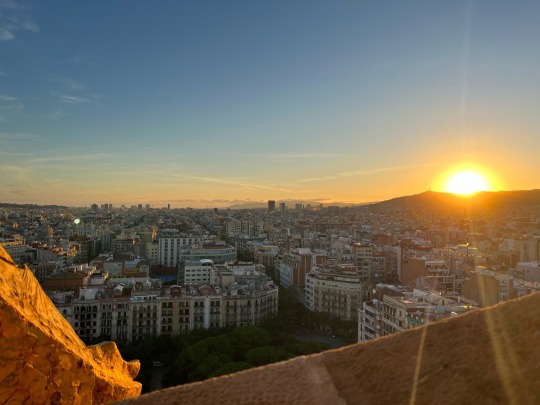



Seeing La Sagrada Familia made me want to do something dumb like move to Barcelona and do a masters or doctoral thesis on it.
It’s magnificent.
#The architecture in Spain#like goddamn#I missed Europe so much#I never want to come back to American though 🙃#I mean my bachelor’s is in film and media studies#doing an art or architectural analysis of it is entirely in line with that actually#And I feel like I could study it for years and still find more to talk about it#La Sagrada Familia#architecture#Barcelona#Spain
16 notes
·
View notes
Text
How Old is Nandor Really?
Hopping back into the meta game after bingeing my way through ‘What We Do in the Shadows’ (TV show), and while I’m sure there’s tons of interesting character analysis and lore analysis to dive into, the first thing that really drew me in was history. Specifically, I found myself wondering if I could use throwaway lines and art history to figure out exactly how old the vampires in WWDITS actually are. Nandor seemed the most possible to pinpoint dates for, as we have more information on his life and turning than any of the others, but it’s also muddled with inconsistencies and historical inaccuracies.
And those inaccuracies are what got me thinking. Nandor gives dates, but he also says that he ruled a country called Al Quolanudar, located in southern Iran, while also being a soldier in the Ottoman Empire. The problem here is that the Ottoman Empire never conquered Persia, and definitely never made it to southern Iran. Nandor is mixing up his own history (something all of the vampires seem to have a tendency to do). He thinks he remembers when he was alive, but timekeeping and dates vary from culture to culture, years get confused, and he is confusing Persia with Turkey, so … yeah, our boy is a very unreliable narrator when it comes to his own history. And that’s why I wanted to see if I couldn’t utilize more concrete information provided by the show, combine it with real-world history, and reconstruct a more accurate timeline for Al Quolanudar than that provided in the show.
Let’s start with dates that seem more certain than Nandor’s faulty memory. According to in-universe Google, we know that Al Quolanudar dissolved in 1401. We also know that Nandor did not know this. Now, it’s possible that he forgot this, just as much as he forgot that Persia and Anatolia are two very different places. But his shock seemed real enough that I’m inclined to believe he got turned and then subsequently exiled from his home country long enough before its dissolution that he never heard about it. My thought is that, after he was exiled, he fled to Anatolia and there became integrated enough into Ottoman vampire life that he conflated his human life and his vampire life. His army while he was human traveled far enough to destroy a village in Greece (Byzantium at the time), so he did probably have some contact with the Ottomans in his lifetime, and after a few centuries he mixed up his life in Persia and his unlife in Anatolia (combined with memories of invading the area with his army during his lifetime) and landed on his mixed-up history.
But how long before 1401 was Nandor exiled? For that, I think we need to turn to IRL Persian history. In the early 1200s Genghis Khan and the Mongols swept into Iran. Prior to their arrival Iran was one of the great cultural hearts of the Islamic world, featuring institutions of learning, architectural innovations, and large libraries. Many of these were destroyed with the Mongol invasion, and the Mongols seized control of the entire Persian region from 1256-1335, during a period referred to as the Ilkhanate. By the end of this period Persian culture was beginning to rebuild, utilizing its position as a crossroads of trade and incorporating art and architecture from Europe, India, Mesopotamia, and China. However, as the Ilkhanate stayed in power the Mongol empire fell apart. An important date for us is 1335, when the last of the Mongol rulers, Abu Said, died and the Ilkhanate dissolved into infighting, civil war, and petty dynasties.
I think this is where Nandor comes in. During a period in which numerous powers, previously kept in check by the Ilkhanate, sprung up to carve up Persia and take their own chunk of it back, it would make sense that a promising young warlord from Al Quolanudar might have been able to carve out a place for himself and to re-establish Al Quolanudar as an independent state. The Mongols and the local Arabian and Persian populations were in ongoing short and prolonged wars with one another from 1335-1381, and then the Turkish Mongol Timur invaded Iran and brutally conquered the area. He finally consolidated all of Persia back under singular reign by 1402.
And there’s a date that’s very close to one we already know. If Al Quolanudar dissolved in 1401 it was likely as part of the final consolidation of the Timur Empire finally reaching the southernmost reaches of Iran.
Given all this information, I think our best bet is that Nandor either established or helped establish an independent Al Quolanudar around 1335 CE (the population likely considered themselves a distinct state before this, but were governed by an imposed Mongol ruler). This would be good reason for him to rule the country he helped liberate right up until he was turned into a vampire. We don’t know how long his reign was, but it was long enough to lead his army pillaging and invading all the way up into Greece, which means they punched their way all the way through the Ottomans and into Byzantium. Even presuming they were tough enough to have managed that (and Nadja is proof that they were), that would have taken a healthy chunk of time. So let’s say he took over the country around the age of 20 and got turned around the age of 40 (running with Kayvan Novak’s age at the start of the series for that reference point). That puts his reign right around 20 years, which seems reasonable given his apparent accomplishments. That also means that he was turned into a vampire around 1350, which gives him half a century to make it to Anatolia, get lost in Ottoman culture, and miss the memo regarding Al Quolanudar being crushed in 1401 when the Timur Empire consolidated power in Persia.
This shaves his age down to more like 700, rather than 750+, but I think it makes the most sense, given the time periods involved, his references to the Ottoman Empire, and IRL Persian history. The dates provided from the 1200s just don’t mesh with the amount of Mongol control over Iran in the 1200s. There might be an argument made that Al Quolanudar was far enough south that Mongol control was shaky and couldn’t maintain control over a small kingdom there, so Al Quolanudar managed to remain independent, but that seems way less likely than it being formerly independent, then under Mongol control, then re-establishing itself as an independent power during the civil wars following the fall of the Ilkhanate.
I have no idea if anyone will enjoy this deep-dive into trying to square actual history with the absolutely mangled history of WWDITS, but for me it was a fun exercise, and I think I managed to make a fairly good go at figuring out a better timeline for Al Quolanudar than the one provided in the show. I have to admit, however, that I’m not an expert on Persian history. If you are I would love to hear any corrections or thoughts you might have on this theory. I would also love to hear your own theories on how Al Quolanuar might fit into IRL Persian history.
(Edited the next morning for non-midnight punctuation and a little more clarity of wording)
#What We Do in the Shadows#WWDITS meta#WWDITS#Nandor the Relentless#of course my first proper post in this fandom is a history essay I wrote at midnight#that's very on brand for me#I have no idea what the overlap between WWDITS and history nerds is#but I aim to find out
90 notes
·
View notes
Text

Modern critics of The Arnolfini Portrait painted by Jan van Eyck are baffled by some of its symbolism, and have engaged in debate about the symbols and meanings behind the double portrait for some time. Many have attempted to analyze these symbols in the context of societal norms of the time, and yet the controversy continues. I propose that there is another, most obvious, though scandalous, and even heretical viewpoint that could settle the debate once and for all.
Erwin Panofsky views the painting as a record of a "marriage by a marital oath, more particularly by joining hands," as the two figures in this double portrait are indeed touching hands in the very center of the image. He assumes the identity of the female figure to be that of Giovanna Cenami, whom a Giovanni Arnolfini living in Flanders at the time did not legally marry until 13 years after van Eyck's painting was completed (Chipps Smith, p. 102-103.) I believe this assumption to be a mistake, because it precludes other possibilities as to the identity of the female figure portrayed by the artist. I do believe that he is correct in the analysis that the painting is a record of some kind of societal contract, akin to a marriage, taking place in the private space of Arnolfini's domicile. I believe it to be more of an allegory to marriage, however, since the historical identity of this female figure remains a mystery, and for all of the historical evidence available, did not exist in live human form at the time that the portrait was painted, in 1434 AD.
Art historian Craig Harbison wrote about The Arnolfini Portrait that, as a wealthy merchant Giovanni Arnolfini was well known for a "pretension to noble status" and that "Arnolfini apparently spent much time courting the Flemish nobility." Harbison comments on the luxurious nature of the couple's dress to support this claim. He relays details of how their dress mimics that of Royalty when he writes, "The somber colors of the man's clothing, dark purple, brown, and black, appropriately mirror the taste of the duke of Burgundy. Cenami's pale complexion is no doubt due to heavily applied makeup favored by courtly women to give a refined impression. Her robe, while not made of particularly costly fabric, has an elegant white fur lining and enormous sleeves decorated with applied dagging." Harbison has overlooked, however, critical details of the female figure's dress that tell of how she is not merely attired luxuriously, but in the exact manner of the Burgundian courtly trends of the time. Isabeau of Bavaria, wife and Queen to Charles VI, was the first woman in recorded history to wear a linen petticoat, and this item was considered the ultimate symbol of luxury and status in her court. Burgundian Ladies, in an effort to display their status, would wear overcoats, the gender neutral houppelande, with cutouts and sleeves designed to give a glimpse of their luxurious linen undergarments. The truncated sleeve of the emerald green houppelande worn by the female figure in The Arnolfini Portrait performs this service perfectly. Yes, it is lined with white fur, as Harbison noted, but more importantly, it shows quite a good portion of the fine linen of her undergarment. Isabeau was also the Queen of wearing high headdresses, particularly heart in shape, and the architecture of palaces was altered to allow ladies of her court ease and comfort in traversing the walkways in their headgear. True to Royal form, the womanly figure that van Eyck portrays in this double portrait is adorned with an elaborate headdress, which accentuates her high forehead. The Burgundian courts valued high foreheads above all other adornments on a noble woman, and the feature was emphasized and valued in portraiture painting of the time. Like the symbol of fertility in gathering the houppelande skirts to one's waistline, the high forehead indicated survival of the plague that had wiped out viable brides of the Royal line. The combination of these details convey to the viewer that the female figure in this painting is of Royal descent, and is likely to continue the Royal bloodline. This figure was painted as if she were nobility, not merely imitating royal descent, and she is declared fertile by her dress. Harbison, like Panofsky, assumed her identity to be that of Arnolfini's future bride, Giovanna Cenami, but I do not believe that she would have worn these styles in exactly this way, having come from the burgher class herself. In fact, Wikipedia states that this marriage was assumed by art historians entirely, and that Arnolfini was never married a second time, as his first wife had deceased before this painting was commissioned.
Why would art historians assume a marriage? I believe it is because they are too literal. Of much debate and mystery is the inscription that the painter placed above the mirror, between the eyes of the two figures, and at eye level in the composition. The inscription reads, "Jan van Eyck was here." It is also situated between the chandelier, which critics claim to represent God, and the mirror, which has been painted in great detail with scenes from the Passion of Christ. Essentially, the artist has placed himself as an authority between the Heavenly and the Earthly realms. Most art historians agree that this inscription is some kind of witness statement, but they cannot agree on what exactly is being witnessed. When I consider that the female figure in this painting is an allegory, a symbol unto herself, of the Burgundian courts and Royalty, I begin to consider that the painter understood that he had been commissioned to document an unprecedented moment in History: the marriage of the burgher class and the nobility. He may have understood that this was a fantasy in Arnolfini's mind, but he also recognized that it was a powerful political statement, and he wanted recognition as offering support to his patron in making this statement. He was indeed an authority to validate the marriage, for as a member of the burgeoning Flemish society of the time, he witnessed the economic exchanges with Royalty and the growing power of the burgher class, quite literally, and on a daily basis.
I believe that it is not an accident that this particular Flemish portrait of the Renaissance has survived, while others have not, for it carries meaning and power of great significance to the evolution of European economics and society. In commissioning Jan van Eyck to paint a portrait of himself marrying Royalty, Giovanni Arnolfini was claiming that his wealth and status as a merchant afforded him the same amount of sovereignty and religiosity of the rulers of the time. This painting documents the beginnings of New Money, and the destruction of the old system, as we saw with the entrenne, where money could not buy power or recognition. The Arnolfini Portrait is so named because it is actually the portrait of one man taking a revolutionary stand in society. The second figure in the double portrait is that of an institution, not an individual person. The allegorical marriage in the painting was conducted in private chambers, an act of defiance in itself, and an official statement that a commoner was procreating with Royalty, with or without sanction. Jan van Eyck was there, and his legacy lives on because he dared to join a contemporary burgher in fighting the status quo. I mean, the strategically placed inscription, which art historians call "odd," rendered him infamous, for centuries, as World War II graffiti can attest. The religious symbols abundant in the painting hint that the commission of this work was indeed sanctioned by a higher authority, a Bishop perhaps, but we lack evidence of this detail, and so the debate continues.
I have no doubt in my mind, however, after reviewing the writings of the aforementioned authors, and others, that Jan van Eyck documented the conception of Modern Capitalism with The Arnolfini Portrait. To take a cue from Vicki Saxon, this painting was more like the Royal Wedding portrait of Harry and Meghan than a Kardashian family portrait. The artist threw in all of those debated symbols of wealth and fertility specifically to inform the audience that they were viewing the birth of a New Age, one resilient with prosperity for the common man, not born to nobility, but married into it by wealth. Jan van Eyck was a master of hyper realistic detail, which was highly valued then and is now, but his genius is in his apparent knowledge of his place in History, as the midwife, or St. Catherine, of the Art World. One need only look to the era of Kilroy to see how the portent of this masterpiece played out. With oil barons buying up noble estates, and the daughters of shipping magnates salvaging the old family name, the Merchant and his Royal Bride were more relevant in the 20th Century than they were in the 15th. Somehow painter and subject were both aware of this, because the state of solemnity that Jan van Eyck painted on Arnolfini's face is so priceless, as he was a visionary looking to a future, centuries and centuries beyond his Worldly grasp. Those unknown figures reflected in the mirror? That is you and me.
Rachel Schultz
Course ARH361U : The Northern Renaissance
Portland State University
Spring 2020
#dark acadamia aesthetic#art in the time of corona#art history#mine#late capitalism#academia aesthetics#chandelier
4 notes
·
View notes
Link
Something strange happened to the news over the past four years. The dominant stories all resembled the scripts of bad movies—sequels and reboots. The Kavanaugh hearings were a sequel to the Clarence Thomas hearings, and Russian collusion was rebooted as Ukrainian impeachment. Journalists are supposed to hunt for good scoops, but in January, as the coronavirus spread, they focused on the impeachment reality show instead of a real story.
It’s not just journalists. The so-called second golden era of television was a decade ago, and many of those shows relied on cliff-hangers and gratuitous nudity to hold audience attention. Across TV, movies, and novels it is increasingly difficult to find a compelling story that doesn’t rely on gimmicks. Even foundational stories like liberalism, equality, and meritocracy are failing; the resulting woke phenomenon is the greatest shark jump in history.
Storytelling is central to any civilization, so its sudden failure across society should set off alarm bells. Culture inevitably reflects the selection process that sorts people into the upper class, and today’s insipid stories suggest a profound failure of this sorting mechanism.
…
Culture is larger than pop culture, or even just art. It encompasses class, architecture, cuisine, education, manners, philosophy, politics, religion, and more. T. S. Eliot charted the vastness of this word in his Notes towards the Definition of Culture, and he warned that technocratic rule narrowed our view of culture. Eliot insisted that it’s impossible to easily define such a broad concept, yet smack in the middle of the book he slips in a succinct explanation: “Culture may even be described simply as that which makes life worth living.” This highlights why the increase in “deaths of despair” is such a strong condemnation of our dysfunction. In a fundamental way, our culture only exists to serve a certain class. Eliot predicted this when he critiqued elites selected through education: “Any educational system aiming at a complete adjustment between education and society will tend to restrict education to what will lead to success in the world, and to restrict success in the world to those persons who have been good pupils of the system.”
This professional managerial class has a distinct culture that often sets the tone for all of American culture. It may be possible to separate the professional managerial class from the ruling elite, or plutocracy, but there is no cultural distinction. Any commentary on an entire class will stumble in the way all generalizations stumble, yet this culture is most distinct at the highest tiers, and the fuzzy edges often emulate those on the top. At its broadest, these are college-educated, white-collar workers whose income comes from labor, who are huddled in America’s cities, and who rise to power through existing bureaucracies. Bureaucracies, whether corporate or government, are systems that reward specific traits, and so the culture of this class coalesces towards an archetype: the striving bureaucrat, whose values are defined by the skills needed to maneuver through a bureaucracy. And from the very beginning, the striving bureaucrat succeeds precisely by disregarding good storytelling.
…
Professionals today would never self-identify as bureaucrats. Product managers at Google might have sleeve tattoos or purple hair. They might describe themselves as “creators” or “creatives.” They might characterize their hobbies as entrepreneurial “side hustles.” But their actual day-in, day-out work involves the coordination of various teams and resources across a large organization based on established administrative procedures. That’s a bureaucrat. The entire professional culture is almost an attempt to invert the connotations and expectations of the word—which is what underlies this class’s tension with storytelling. Conformity is draped in the dead symbols of a prior generation’s counterculture.
…
When high school students read novels, they are asked to identify the theme, or moral, of a story. This teaches them to view texts through an instrumental lens. Novelist Robert Olen Butler wrote that we treat artists like idiot savants who “really want to say abstract, theoretical, philosophical things, but somehow they can’t quite make themselves do it.” The purpose of a story becomes the process of translating it into ideas or analysis. This is instrumental reading. F. Scott Fitzgerald spent years meticulously outlining and structuring numerous rewrites of The Great Gatsby, but every year high school students reduce the book to a bumper sticker on the American dream. A story is an experience in and of itself. When you abstract a message, you lose part of that experience. Analysis is not inherently bad; it’s just an ancillary mode that should not define the reader’s disposition.
Propaganda is ubiquitous because we’ve been taught to view it as the final purpose of art. Instrumental reading also causes people to assume overly abstract or obscure works are inherently profound. When the reader’s job is to decode meaning, then the storyteller is judged by the difficulty of that process. It’s a novel about a corn beef sandwich who sings the Book of Malachi. Ah yes, a profound critique of late capitalism. An artist! Overall, instrumental reading teaches striving students to disregard stories. Cut to the chase, and give us the message. Diversity is our strength? Got it. Throw the book out. This reductionist view perhaps makes it difficult for people to see how incoherent the higher education experience has become.
…
“Decadence” sounds incorrect since the word elicits extravagant and glamorous vices, while we have Lizzo—an obese antifertility priestess for affluent women. All our decadence becomes boring, cringe-inducing, and filled with HR-approved jargon. “For my Fulbright, I studied conflict resolution in nonmonogamous throuples.” Campus dynamics may partially explain this phenomenon. Camille Paglia has argued that many of the brightest left-wing thinkers in the 1960s fried their brains with too much LSD, and this created an opportunity for the rise of corporate academics who never participated in the ’60s but used its values to signal status. What if this dropout process repeats every generation?
…
The professional class tells a variety of genre stories about their jobs: TED Talker, “entrepreneur,” “innovator,” “doing well by doing good.” One of the most popular today is corporate feminism. This familiar story is about a young woman who lands a prestigious job in Manhattan, where she guns for the corner office while also fulfilling her trendy Sex and the City dreams. Her day-in, day-out life is blessed by the mothers and grandmothers who fought for equality—with the ghost of Susan B. Anthony lingering Mufasa-like over America’s cubicles. Yet, like other corporate genre stories, girl-boss feminism is a celebration of bureaucratic life, including its hierarchy. Isn’t that weird?
There are few positive literary representations of life in corporate America. The common story holds that bureaucratic life is soul-crushing. At its worst, this indulges in a pedestrian Romanticism where reality is measured against a daydream, and, as Irving Babbitt warned, “in comparison . . . actual life seems a hard and cramping routine.” Drudgery is constitutive of the human condition. Yet even while admitting that toil is inescapable, it is still obvious that most white-collar work today is particularly bleak and meaningless. Office life increasingly resembles a mental factory line. The podcast is just talk radio for white-collar workers, and its popularity is evidence of how mind-numbing work has become for most.
Forty years ago, Christopher Lasch wrote that “modern industry condemns people to jobs that insult their intelligence,” and today employers rub this insult in workers’ faces with a hideously infantilizing work culture that turns the office into a permanent kindergarten classroom. Blue-chip companies reward their employees with balloons, stuffed animals, and gold stars, and an exposé detailing the stringent communication rules of the luxury brand Away Luggage revealed how many start-ups are just “live, laugh, love” sweatshops. This humiliating culture dominates America’s companies because few engage in truly productive or necessary work. Professional genre fiction, such as corporate feminism, is thus often told as a way to cope with the underwhelming reality of working a job that doesn’t contribute anything to the world.
There is another way to tell the story of the young career woman, however. Her commute includes inspiring podcasts about Ugandan entrepreneurs, but also a subway stranger breathing an egg sandwich into her face. Her job title is “Senior Analyst—Global Trends,” but her job is just copying and pasting between spreadsheets for ten hours. Despite all the “doing well by doing good” seminars, the closest thing she knows to a community is spin class, where a hundred similar women, and one intense man in sports goggles, listen to a spaz scream Hallmark card affirmations.
…
The bureaucrat even describes the process of rising through fraudulence as “playing the game.” The book The Organization Man criticized professionals in the 1950s for confusing their own interests with those of their employers, imagining, for example, that moving across the country was good for them simply because they were transferred. “Playing the game” is almost like an overlay on top of this attitude. The idea is that personal ambition puts the bureaucrat in charge. Bureaucrats always feel that they are “in on the game,” and so develop a false sense of certainty about the world, which sorts them into two groups: the cynics and the neurotics. Cynics recognize the nonsense, but think it’s necessary for power. The neurotics, by contrast, are earnest go-getters who confuse the nonsense with actual work. They begin to feel like they’re the only ones faking it and become so insecure they have to binge-watch TED Talks on “imposter syndrome.”
These two dispositions help explain why journalists focus on things like impeachment rather than medical supply chains. One group cynically condescends to American intelligence, while neurotics shriek about the “norms of our democracy.” Both are undergirded by a false certainty about what’s possible. Professional elites vastly overestimate their own intelligence in comparison with the average American, and today there is nothing so common as being an elitist. Meanwhile, public discourse gets dumber and dumber as elitists spend all their time explaining hastily memorized Wikipedia entries to those they deem rubes.
…
The entire phenomenon of the nonconformist bureaucrat can be seen as genre inversion. Everyone today grew up with pop culture stories about evil corporations and corporate America’s soul-sucking culture, and so the “creatives” have fashioned a self-image defined against this genre. These stories have been internalized and inverted by corporate America itself, so now corporate America has mandatory fun events and mandatory displays of creativity.
In other words, past countercultures have been absorbed into corporate America’s conception of itself. David Solomon isn’t your father’s stuffy investment banker. He’s a DJ! And Goldman Sachs isn’t like the stuffy corporations you heard about growing up. They fly a transgender flag outside their headquarters, list sex-change transitions as a benefit on their career site, and refuse to underwrite an IPO if the company is run by white men. This isn’t just posturing. Wokeness is a cult of power that maintains its authority by pretending it’s perpetually marching against authority. As long it does so, its sectaries can avoid acknowledging how they strengthen managerial America’s stranglehold on life by empowering administrators to enforce ever-expanding bureaucratic technicalities.
…
Moreover, it is shocking that no one in the 2020 campaign seems to have reacted to the dramatic change that happened in 2016. Good storytellers are attuned to audience sophistication, and must understand when audiences have grown past their techniques. Everyone has seen hundreds of movies, and read hundreds of books, and so we intuitively understand the shape of a good story. Once audiences can recognize a storytelling technique as a technique, it ceases to function because it draws attention to the artifice. This creates distance between the intended emotion and the audience reaction. For instance, a romantic comedy follows a couple as they fall in love and come together, and so the act two low point will often see the couple breaking up over miscommunication. Audiences recognize this as a technique, and so, even though miscommunication often causes fights, it seems fake.
Similarly, today’s voters are sophisticated enough to recognize the standard political techniques, and so their reactions are no longer easily predictable. Voters intuitively recognize that candidate “debates” are just media events, and prewritten zingers do not help politicians when everyone recognizes them as prewritten. The literary critic Wayne Booth wrote that “the hack is, by definition, the man who asks for responses he cannot himself respect,” and our politicians are always asking us to buy into nonsense that they couldn’t possibly believe. Inane political tropes operate just like inane business jargon and continue because everyone thinks they’re on the inside, and this blinds them to obvious developments in how audiences of voters relate to political tropes. Trump often plays in this neglected space.
The artistic development of the sitcom can be seen as the process of incorporating its own artifice into the story. There is a direct creative lineage from The Dick Van Dyke Show, a sitcom about television comedy writers, to The Office, a show about office workers being filmed for television. Similarly, Trump often succeeds because he incorporates the artifice of political tropes. When Trump points out that the debate audiences are all donors, or that Nancy Pelosi doesn’t actually pray for him, he’s just pointing out what everyone already knows. This makes it difficult for other politicians to “play the game,” because their standard tropes reinforce Trump’s message. If the debates are just media spectacle events for donors, then applause lines work against you. It’s similar to breaking the fourth wall, while the rest of the cast nervously tries to continue with their lines. Trump’s success is evidence that the television era of political theater is ending, because its storytelling formats are dead.
In fact, the (often legitimate) criticism that Trump does not act “presidential” is the same as saying that he’s not acting professional—that he is ignoring the rules of bureaucratic advancement. Could you imagine Trump’s year-end review? “In 2020, we invite Donald to stop sending Outlook reminders that just say ‘get schlonged.’” Trump’s antics are indicative of his different route to power. Forget everything else about him: how would you act if you never had a job outside a company with your name on the building? The world of the professional managerial class doesn’t contain many characters, and so they associate eccentricity with bohemianism or ineptitude. But it’s also reliably found somewhere else.
Small business owners are often loons, wackos, and general nutjobs. Unlike the professional class, their personalities vary because their job isn’t dependent on how others view them. Even when they’re wealthy or successful, they often don’t act “professional.” It requires tremendous grit and courage to own a business. They are perhaps the only people today who embody what Pericles meant when he said that the “secret to freedom is courage.” In the wake of coronavirus, small businesses owners stoically shuttered their stores and faced financial ruin, while politicians with camera-ready personas and ratlike souls tried to increase seasonal worker visas.
…
Ever since Star Wars, screenwriters have used Joseph Campbell’s monomyth to measure a successful story, and an essential act one feature is the refusal of adventure. For a moment, the universe opens up and shows the hero an unknown world of possibility, but the hero backs away. For four years, our nation has refused adventure, yet fate cannot be ignored. The coronavirus forces our nation to confront adventure. With eerie precision, this global plague tore down the false stories that veiled our true situation. The experts are incompetent. The institutions told us we were racist for caring about the virus, and then called for arresting paddleboarders in the middle of the ocean. Our business regulations make it difficult to create face masks in a crisis, while rewarding those who outsource the manufacturing of lifesaving drugs to our rival. The new civic religion of wokeness is a dangerous antihuman cult that distorts priorities. Even our Hollywood stars turn out to be ugly without makeup.
5 notes
·
View notes
Photo

I’d comment that Phos’s complaint about the final level of their game being ridiculously hard is a metaphor for how their entire quest gets exponentially more difficult as it approaches its conclusion, but the blurb in the margins already points out that parallel, so I guess my observation is redundant. The accursed little thing is stealing my thunder.
Click the read more if you want to see me read way too much into the art.
Before I get into gushing over the artwork, I want to go over some of my thoughts on the narrative side of things, so let’s get the most annoying part out of the way first and talk about Aechmea.

I’ve heard that in the original Japanese, it’s clear that he’s referring to Cairngorm. What’s interesting here is that he said this line when it seemed for a moment that Kongou was about to release the Lunarians. But now that it’s clear it won’t happen, I wonder whether or not he’ll actually say what was on his mind. In any case, I can’t wait to see more of his ugly mug next chapter. Yay.
This chapter has sparked a bit of discourse regarding the earth gems, so I might as well chime in. While I agree that the earth gems’ reaction isn’t unreasonable given the circumstances and the limited information at their disposal, it’s still not really the best reaction they could have had. Regardless of their interpretation of Phos, the truth of the matter is that the version of Phos that the other gems feel the need to shatter, tie down, cage, and then shatter again is less of a threat to Kongou than the one they let walk around freely in chapter 58. Just because what they’re doing is understandable, doesn’t mean that what they’re doing is right, and I don’t think that this pattern of shooting first and asking questions later is a good road for them to collectively go down.
And on the subject of Euclase, to reiterate what I’ve said before: they give me the willies not because I think their actions are totally unreasonable, (though said actions do tend to be on the more militant side of what could be considered reasonable, don’t they?) Rather, a lot of the bad vibes I get from them are because of the menacing manner with which Ichikawa sometimes frames them, in addition to Padparadscha’s seemingly less-than-charitable opinion of them.
I’ve been curious for a while now about how Rutile would react after Padparadscha outright rejected them. Looks like they’ve just doubled down on their obsessiveness, to the point of doing a stellar Onryō impression. Really, the quickest way to ruin a relationship in this story is to either take someone for granted, or to be possessive/controlling. Phos has some issues with the former, but a number of the other characters have a strong case of the latter, case in point being Rutile here.
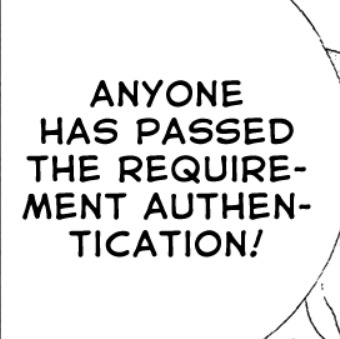
I’m guessing that this implicitly confirms that the human particle is indeed in Phos’s eye? I doubt that Kongou’s human sensors would go off due to Phos being merely metaphorically human. I’ve also seen people posit that the reason Kongou can’t release the Lunarians is because his one-way ticket to nirvana only works on less sentient life forms. (@rinboz has a good analysis that touches on this topic, btw.) I think the chapter confirms this interpretation based on Phos’s mysteriously disappearing cage. And that dovetails nicely into my thoughts on the art of this chapter…
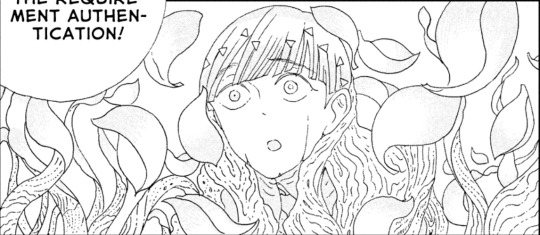
Because the imagery of the cage coming to life, flowering, and vanishing in a breeze of petals is *chef’s kiss* gorgeous.
The scene starts off in gray and black, and the panels have a cluttered, claustrophobic feeling to them from the grain of the wood and the shadowy, looming architecture. But once Kongou begins his prayer attempt, the panels start to become more spacious, those grays and blacks giving way to sleek monochrome. Finally, this changes to stark white with minimal linework and virtually no shading. The only other time I can recall Ichikawa using this blank, simplified style in hnk was when we saw a brief flashback of Phos as a child. (For a given value of “child,” we are on arrested development island after all.)
The way the cage seemingly transformed back into an earlier phase of its existence before vanishing reminds me of how Shiro went back to being a dog for a few moments before he left. So, it seems that Kongou’s attempt worked just fine on a wooden cage—i.e, a plant—but none of the sentient beings present could actually be affected.
Once he fails, the shroud of grey once again falls over the scene, black arches closing in. And yet when the “camera” turns to Phos, their greyscale body is surrounded by white, as if the pure vision they had just seen is still haunting them.
I’m just in awe of how perfectly the environment here mirrors Phos’s emotional state. Their heavy bondage flies away in a flurry of petals just as they’re getting their hopes up, and in the moment that those hopes are dashed, the rain of blades that shatter them are represented as black bars caging their mangled body. Have I said before that Ichikawa is an absolute master of visual metaphor? Because she is.
I was so fond of the art, as a matter of fact, that I reread the chapter several times and kind of. Stared at it for a couple hours. Here’s some interesting things I noticed.
In chapter 71, Cinnabar’s mercury globules were gone, but now they’re back. Were they gone before because Cinnabar had just unloaded a bunch of mercury the previous chapter, or could there be some other reason? Also in regards to Cinnabar, they’re present while Phos confronts Kongou, just barely visible on the far left—note the floating mercury.
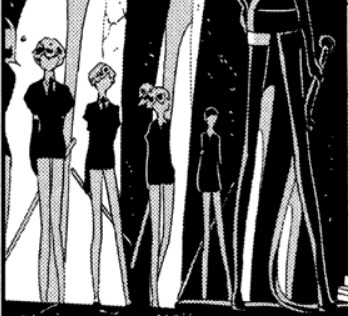
But at no point does Ichikawa let us see their face or what they think of all this—more on this in a moment.
Bort doesn’t seem to be wearing powder on their left leg. It’s the same leg that Phos shattered, and as far as we know, that’s the only time they’ve ever been broken, so maybe they’re leaving that leg bare as a reminder? That seems like the sort of samurai-esque thing Bort would do.
Everyone’s started wearing gloves. Before, the gems with a <9 hardness would only wear gloves if they anticipated having to touch someone or something with a different hardness level, (or in Cinnabar’s case, if they didn’t want to contaminate the things they touch.) But in this chapter, everyone’s wearing gloves the whole time. There are two possibilities that come to mind for me. One is that since the earth gems have to anticipate fighting other gems instead of cloud-people, they have to worry about abrasions to their hands while fighting, and are thus patrolling with gloves. The other possibility is that since Cinnabar has been fully (?) integrated into the group again, everyone has to be careful of what they touch, and they’ve taken to wearing gloves to lessen the risk of being contaminated by mercury.
Peridot and Sphene aren’t wearing gloves while patrolling in chapter 69, even though the earth gems were definitely counting on fighting the gems on the moon sooner or later, which makes me think it’s more likely that Cinnabar is the reason everyone’s wearing gloves. Maybe it went something like this: up until the night raid, Cinnabar hadn’t been living with the other gems despite the fact that they must have been engaging with them. But after the night raid, they start living with the others in the school, thus necessitating the gloves.
Once the sleep deprivation started kicking in I found myself engaging in the potentially meaningless venture of counting swords, gems, and who had swords and who didn’t in the second half of the chapter. I may have found a couple of interesting things, so get your tinfoil hats ready.
On this page, we see all the earth gems sans Jade and Euclase, and of those gems, Sphene, Cinnabar, Obsidian, and Red Beryl are unarmed. My first observation is that one of the gems who was unarmed grabbed a sword from somewhere and threw it at Phos. There are only seven swords on this page, but—not counting Rutile’s scalpels—there are eight swords on the ground on the final page.

Which begs the question: who threw the mystery sword? We can rule out Jade or Euclase; they were standing in front of Phos and it’s clear from the positions of the blades on the ground that they were all thrown from behind. Best-case scenario is that Sphene simply set their sword aside while checking the cage and grabbed it again off-panel. Worst-case scenario would be if Cinnabar was the one who chucked the eighth sword at Phos. I’m just gonna hope that they’re too frail to pick up a sword in the first place; please don’t dash my hopes Ichikawa.
Speaking of which, on the penultimate page, there are eight lines piercing Phos—one for each sword on the last page. This makes me wonder: did Bort not attack Phos here? Their whip is seemingly unrepresented in the stylized depiction of the weapons that shattered Phos, and it’s not entirely clear from the last page whether they used it or not. Then again, Rutile’s scalpels are on the ground on the last page but absent from the previous page, so maybe I’m reading too deeply into it. But the fact that Ichikawa was careful enough to have the number of swords match the number of black lines makes it a possibility worth keeping in mind.
This is what happens when I’m assigned to read The Tedious Misadventures of Tristan and Isolde. I start procrastinating by going all True Crime over who exactly murdered Phos. Anyway, see you guys next month when we find out whether the earth gems were nice enough to put Phos back together or if they just chucked the pieces out to sea.
146 notes
·
View notes
Text
DIGITAL MARKETING 101; CREATING CONTENT TO ENSNARE THE MILLENNIAL HEART
Content is everything.
Content is king.
As digital marketers, we’ve read this proclamation so many times it’s burned in our brains. It’s been said over and over and over- so much that when I see the word “content”, it’s the first thing that comes to my mind. And it certainly is true.
Content still is, and would almost certainly always be, king.
It’s the heart and soul of every campaign. It’s the building blocks where we build our social media following. It’s the magnet that attracts behind every advertisement. It sends our narrative, our story, our message across to our target audience.
It builds credibility.
It establishes authority.
It attracts- which, I think, is its most basic, yet most important function for those of us who use it primarily for marketing.
Now the question arises.
Who do we want to attract?
Of course it’d be nice to think that we could write a piece that would engage and attract the attention of every group and denomination. But we have to be realistic and set our goals accordingly. Every time we create content, just as we always think about the quality of the article, or the infographic, or the podcast that we are creating, we should also be keeping in mind the people who we want to be on the receiving end of our finished product.
For me, those people more-often-than-not, turn out to be millennials. Which then, brings us to the title of this article:
DIGITAL MARKETING 101; CREATING CONTENT TO ENSNARE THE MILLENNIAL HEART
When we think about millennials, most of us often scrunch up our noses and think, pumpkin spice latte, twitter rage, trophies, student debts, entitlement etc. Which is a bunch of harmful stereotypes that does not exactly promote generational unity, but let’s not talk about that.
Instead, let’s define the term: Millennial.
Contrary to popular belief, millennials are not teenagers. Millennials are young adults, whose age range typically fall between 18-35 years, sometimes older (different groups have different opinions on the exact range). To clear any misconceptions, here is the general agreed upon birth years for different generations:
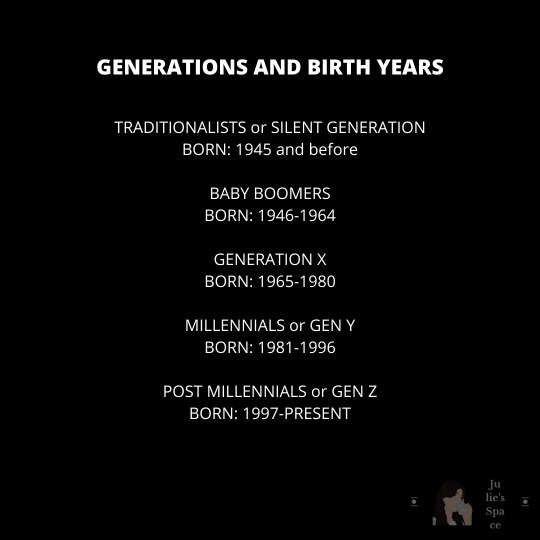
And according to Pew Research Center analysis of U.S. Census Bureau data, Millennials are actually the largest generation in the U.S labor force.
Which is good news for me, and other digital marketers and content creators whose target audience are millennials, for the most part. Because it means that the people we are writing for are earning money. It sounds mercenary, but again- let’s be real here. The main reason why we do content marketing is to attract customers. Prospective clients.
Buyers.
Since the mediums wherein most content creators like me disseminate our pieces are found in the internet, it’s also important to know just how much of our intended audience actually have access in it.
Statista, a site that publishes statistical analysis of facts and figures recently released the following:
SHARE OF ADULTS IN THE UNITED STATES WHO USE THE INTERNET IN 2019, BY AGE GROUP
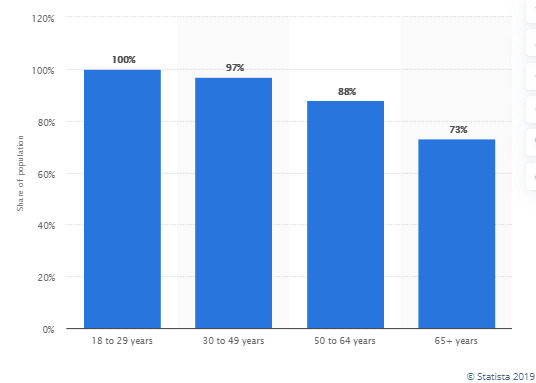
“The statistic shows share of internet users in the United States in 2019, sorted by age group. During the survey period, it was found that 100 percent of 18 to 29-year olds in the United States were internet users. Overall, 90 percent of the adult U.S. population accessed the internet.”
–STATISTA
The glaring numbers don’t lie. A huge chunk of the majority of the people actually spending time in the internet are- you guessed it- young adults. Again, good news for us, right?
Well, yes.
Also, not entirely.
See, just because they are in the internet, or are in social media, does not mean that they are instantly going to fall heads over heels with our content. Just because I published an article on Tumblr, or posted a link to my blog on Facebook and they happened to see it, does not mean that millennials will automatically start sharing and hitting the like button. There’s always the chance that they might ignore it. Or worse, start hating it so much that I become a victim to the of the prevalent boycott movement, the cancel culture.
Yes, that’s a thing now.
Millennials are like a double-edged sword, so to speak.
There are a lot of pitfalls in making them our target viewers, to be sure. But if there’s one thing that I know from experience, it’s this: the gains and advantages that can be reaped from having millennials as an audience far outweighs the cons.
Having said all that, it’s also very important to remember that this generation is not exactly impossible to please. To capture their attention, there are few things that can be implemented that won’t necessarily cost any money- just a considerable amount of effort from our part.
1. Be conscious of political correctness
Generation Y is a generation of socially conscious individuals. Remember, that these people were raised in a time where equality and awareness are the main advocacies. I am not saying that we need to start turning our backs on our own political beliefs and start catering to theirs- let’s just be mindful enough not trip over sensitive issues in our content unless that is exactly what our purpose is. Let’s try to avoid publishing material that blatantly belittles or discriminates against people because of their race, body type, hair, gender, age, culture, fame (or lack thereof), social status etc. The general rule of the thumb is, to be nice as much as we can, and respect people the way that we want to be respected.
2. Be aware of trends
I’m not talking about eating Tide Pods or mimicking other challenges that are physically harmful. I’m talking about trends in technology, software and social media updates, fashion, clothing lines, restaurants, travel, philanthropic acts and charitable institutions, art, architecture. Of course, we all have our own niche to pay attention to, but with a little bit of effort, there’s an unending number of trending topics out there that are just waiting to be featured no matter what industry we are currently focusing on.
3. Stop sounding like salesperson
In my opinion, this does not just apply to millennials, but to every audience subtype. Stop being so obvious that you are selling something. Instead, tell a story. Make your viewers empathize. Be a friend- someone who actually cares and someone who they can relate to.
Don’t tell them:
Buy my shoes. They have great price compared to other shoes.
Instead, tell them:
I have worked in a corporate office almost all of my adult life, and have always worn heels. I have shed copious amounts of tears from bleeding blisters, and have since learned to always keep a supply of band-aids in my purse and a small first-aid kit in my desk. But what can I do? There’s an office dress code that I apparently agreed to when I signed my contract. I could quit- but then what’d I do for my bills? Should I tell my mother I am unemployed, because I didn’t like my shoes?
That’s when I started to think- why not make my own? Something that I can actually design, something that is comfortable and does not cost a house mortgage.
See where I’m going with this? With more time effort, it’s not impossible to make the part that advertises a certain product or service even more low-key than this. We have to make our selling points part of the natural flow of the narrative. Remember: subtlety is the key.
4. Use millennial buzzwords
Language is dynamic. It’s constantly changing. Time, geographical location, culture, events- these things and more affect the evolution of language so much and with such consistency that it’s almost impossible to determine its original state. As years pass by, people incorporate more and more slangs and new terminologies in their everyday lives.
I won’t say that it’s absolutely necessary to imbue our every article with terms like bop, lit, or salty- just that there are certain terms or “buzzwords” that we can add in our writing that would make us seem more like a peer than a lecturer. It sounds silly, I know, but the goal is to be relatable. Here are some of the words that millennials have been known to use in the past year that could also be used in creating content, within the right context, of course:
Spill the tea
The struggle is real
Trolls
Goals
On fleek
Clap back
Break the internet
Said no one ever
Slay
Adulting
Here’s another advice- we don’t necessarily have to over-stuff our sentences with these buzzwords. Let it flow naturally. The secret is to sound casual, not to overdo the whole thing and end up sounding silly.
5. Inform and educate
The last, but most certainly not the least. The internet, for most of its users, act heavily as a source of information. When people read articles, guides, tutorials, and other types of content, one of the main reasons that they do so, is to learn. But in the event when people are reading for entertainment purposes, it’s still important to make sure that they get to take something out of it.
And even when we end up writing about, say, the dazzling blue waters of a certain Polynesian island, or the breathtaking view atop the Grand Canyon, let’s make sure to inject bits and pieces of interesting facts and advice that would make the reading experience not just fun, but also enriching in a way that would encourage visitors not just to return, but to also share our material to the rest of the digital world.
From the rise to the number of users for the information crowdsourcing site Quora, to the popularity of online entities Mashable, and the types of articles, infographics, quotations, and other forms of shareable materials that young adults are sharing on social media platforms, it is evident that millennials are leaning more and more towards content that contains fascinating information.
It is important to note that most people are heavily motivated by the desire to share something that they think others would also like. For our part, we have to make sure that our products are sufficiently valuable and are interesting enough to warrant their reposts and willing dissemination.
Final words
Always be reminded that in digital and content marketing, researching about the target audience is as important as ensuring that the technical aspects of content creation are on point, and that learning about the trends in the behaviours and opinions of the people we want to send our message to is absolutely vital, because it helps us tailor our content to their tastes and interests.
#contentmarketing#content writing#contentcreator#contentcreation#digitalmarketing#digitalmarketer#blog#blogging#blogger
4 notes
·
View notes
Text
Beginning the long journey... (Year 0, Day 1 [sorta])
As I begin down this long and arduous path, I figured why not catalog all of my progress (and failures) in a blog for the world to see!

All memes aside, I should probably begin with an
INTRODUCTION:
I’m Manuel; my friends call me Manny. I’m a recent graduate from a bachelor of music (B.Mus) program in southern California where I was fortunate enough to meet some great friends, mentors, and professionals who helped guide and inspire me to create some awesome aural artwork. I’ve loved music for as long as I could remember, and it was always something that drove me to be my best. I’ve aspired to play many instruments from a young age and always sought perfection trying to master their intricacies. I studied both composition and saxophone performance in college, while frequently freelancing as an audio engineer (my current line of work).
But wait, isn’t this a game development blog?: Yes, yes it is.
Due to a variety of circumstances and personal interests, I’ve decided to jump ship from one extremely difficult creative field (concert/classical/experimental music) to another (game development), leaving behind a life I feel indebted to and, honestly, still love very much. I’ve been thinking of making this jump for quite some time (a year or so), with a long, loooooong history of engaging with the video game medium on a deeply-infatuated level, which ultimately backs up this decision. Throughout my life, video games always played a pivotal role in my own forms of expression, happiness, leisure, and community. From my very first Gameboy Color to the now flourishing Nintendo Switch, from Pokemon to Monster Hunter to Bioshock and more, I’ve been hooked. Honestly, I’ve always considered these worlds my second, third, fourth, and n-th homes. Because of this, I’ve felt like I have a duty to give back to the community however I can. After five years of collegiate study and ridding the struggle bus, I realize that there’s no better time than the present to chase this dream. THE NOW, or WHERE TO START:
In firmly deciding on this change, I didn’t necessarily know where to begin. Hell, I didn’t even really know what careers or roles existed in the game development community. After finding scouring the internet and finding some helpful resources, I was blown away at the sheer amount of readjusting I’d need to do to even think about entering this field.
For example, this messy bundle of terms flooded my brain while trying to get a grasp of the industry:
Senior-level
Lead
Technical Director
Junior-level
Temp
Frequent moving
Designer
Level Design
Mechanics
Game Design Document
UX/UI
Programmer
Game Engine
Systems
Game Engines:
Unreal
Unity
Doom
Quake
C++
Python
Scripting
Engineer
Architecture
Audio
Tools
Networking
Artist
Environment Artist
Concept
3ds MAX
Maya
Autodesk
Animation
Skeletal Meshes
QA
Automated Scripting
Debug Databases
Localization
Producer
Disengaged from content creation
Overseer
Independent
Freedom to create vs automated jobs in AAA
AAA companies
Subsidiary studios
Outsourcers
Art
Animation
Publishing
Audio
First-Party Studios
Publishers
Outsourcing
Non-Disclosure Agreements (NDAs)
Marketing
Analysts
Free-to-Play
Microtransactions
Community
Blogging
Twitch
Streamers
Issues
Pay Disparity
Poverty
Under-appreciated
Sexism
Representation
Minorities/POC
And this list over-simplifies the complex web these roles create with each other. That being said, the last month or so has consisted of me scouring the internet for resources, deciding on what my long-term and short-term goals are, and orienting myself towards taking on Goliath.
MOVING FORWARD:
After being bombarded with this information, I decided that the best course of action for moi was to shoot for a game engineering/programming role, as I also had a brief two-year stint in astrophysics research and STEM coursework during my undergraduate degree. Another one of my passions, the STEM fields have always held a dear place in my heart and I picked up a lot of programming skills/languages in college, notably Java & Python. Intensive music study has also done wonders for the technically-oriented work I currently do, so I figured it would be fun to challenge myself with STEM-oriented work once again. So far, I hold a great, great admiration for lead game designers like Hideo Kojima and others, so design is also something I’m looking into. RESOURCES:
In doing my research, I’ve found a variety of extremely helpful resources that provided me with the insight to start this journey. I’ll post the most helpful ones below: GameDevUnchained (Podcast/Website):
This podcast, hosted by Brandon Pham & Larry Charles (both established AAA game developers), explores the current state of affairs in the video game industry. Their conversations are filled with wit, charm, and tons of information, from wage negotiation and employment to indie development and technical direction. No topic is missed* (well, except for the exact technical aspects of being an artist, developer, or programmer). Despite this slight oversight, it’s still worth its weight in gold due to the fact that they bring in a new guest every week who touches on a specific topic. I’ve gained most of my working knowledge about the industry’s complexities from this source. [Currently on episode: 26] Game School Online (GSO):
This revolutionary piece of pedagogy is an online game development school that is ENTIRELY FREE. Founded and ran by the hosts of GameDevUnchained, GSO’s main focus is free game development education with a focus on artwork, modeling, and technical artistry done through the Unreal 4 engine. The school is optionally supported through Patreon and provides special benefits to subscribers; however, a subscription isn’t necessary to enroll. Enrollment periods happen 4 times a year, with heavy waitlists for non-subscribers due to the need to keep class numbers down. Their educators consist of “Scholars” who teach and monitor the courses, all of whom are active AAA/Indie developers. Notable Scholars include Brandon Pham, Larry Charles, Leo Gonzales, Olaf Piesche (my mentor!), Matt Brown, Tai Chen, and many others. For subscribers, there’s the option to interact 1-on-1 with scholars, serving as lessons and mentorships to poise the budding student to enter the field. I’m currently a $40/month subscriber, which gets me a 30-minute session every month with Olaf. I’d like to stress, however, that at its current state GSO seems heavily oriented towards artists, with the art-oriented roles overshadowing the engineer/programmer roles 8-to-2. In addition, all classes are oriented towards art or design. This means Olaf & Matt are only doing 1-on-1 sessions. -_- *Oh well, better than nothing.*
The next two are both variations on the paid-online-schooling trope, but they seem alright nonetheless...
Coursera:
Coursera is a platform that hosts specialized “certification” courses that were designed by universities around the world. These certification courses are essentially a compilation of videos, assignments, and online templates that are moderated by online staff (and presumably not monitored by the actual course instructors ever). Each certification consists of about 4-6 classes and takes anywhere from 6 months to a year to complete. Each class runs an average of 1-2 months and has about 1 assignment due every week. There is a peer-grading system which can be iffy at times, but it’s worked out well for me so far. The only downside is that these courses can be EXPENSIVE; however, there are financial aid options for those of us *ahemmeahem* that can’t afford the costs. Luckily, my cost for the first class was waived completely. I’m currently enrolled in the Game Design certification course created by Cal Arts. I’ll be updating you all on my progress every week as I work through this course. Something odd I’ve noticed is that the videos for the Intro to Game Design course are astoundingly short; I’m surprised this course costs anything at all given the kind of information I’ve received out of it so far.
Udemy:
Like its quasi-academic counterpart, Udemy hosts courses created by content creators (I’m not too sure on the qualifications these creators have...) that consists primarily of video tutorials. The beautiful thing about Udemy is that, unlike Coursera, their courses often times cost very little if you go through the right channels! This means promo codes from websites like IGN or your favorite tech reviewer, etc etc. I was fortunate enough to grab the Unreal Crash Course course for $10 through an IGN promotion last month. Also unlike Coursera, there are no assignments or grading systems in place for your work. Instead, there are often forums that host dozens and dozens of posts from current and past students of the course. This feature has felt surprisingly fresh and fun; however, not receiving a lot of direct feedback has its downsides. I’ve been slowly chugging away at this course, having finished 1/4th of it so far. I’ve also found that there tends to be much more technical work to be learned from Udemy as opposed to Coursera (in terms of game development); however, this may just be my limited scope, as I haven’t looked around too much more.
Game Engine Architecture, Third Edition by Jason Gregory
(Naughty Dog Lead Programmer):
This book is AMAZING for the aspiring game engineer, as it’s filled to the brim with a detailed analysis of common game engine architecture as told by the lead programmer at Naughty Dog (go Uncharted/Last of Us teams!!!!). I’m currently in the second chapter of the book, but to give a brief overview of its entirety along with my own descriptions below each heading:
Introduction
“discusses the ins and outs of the industry
Tools of the Trade
“an in-depth look into programming tools”
Fundamentals of Software Engineering for Games
“development cycles and tool usage”
Parallelism and Concurrent Programming
“the title says it all”
3D Math for Games
“3D geometry and Linear Algebra, along with programming algorithms” (go STEM!)
Engine Support Systems
“a look at memory and systems”
Resources and the File System
“how to handle game assets”
The Game Loop and Real-Time Simulation
“graphics rendering loops and gameplay loops, along with dealing with time”
Human Interface Devices
“dealing with I/O”
Tools for Debugging and Development
“the title says it all”
The Rendering Engine
“rasterization and rending pipelines”
Animation Systems
“skeletal meshes and processing”
Collision and Rigid Body Dynamics
“physics systems and other collision systems” (go STEM!)
Audio
“Dealing with sound design and 3D audio” (go music!)
Introduction to Gameplay Systems
“dealing with data, game objects, and world editors”
Runtime Gameplay Foundation Systems
“dealing with all of the constituent parts and updating the game”
You mean there’s more?
“more to be learned”
As you can tell, there’s a whole lot of information to be gained by reading a textbook like this. Jason states in the Foreword that this is really meant to be used to teach a three-class series on game programming at the university level; however, I find that you’ll be able to understand a lot of this pretty well so long as you have an ample amount of programming experience (preferably with C++). That being said, it’s a perfect springboard for me and I’m so eager to continue that I sort of want to finish writing this entry already so I can get back to it! *o* It cost about $85 for a physical copy and $47 for a digital copy (Kindle).
So, that wraps up my currently used resources list! I hope it can serve as a starting point for some of your own deep-dives into the world-wide-web for resources! CONCLUSION: Thanks for sticking with me this far everyone. I know I didn’t dive into my past that much, but I hope it gives you somewhat of an idea as to who I am. In starting this journey, I’ve realized the importance of documentation and reaching out to build a community with others, so I hope that we can all interact and take this journey together, in some form. Tomorrow I’ll be delving into my current projects that I’m aiming to work on and some of my personal inspiration for taking the game development plunge, as well as discuss what I’m currently working on in terms of study/development. I hope you all have a good day, and never feel like it’s too late to start chasing your dreams again! - Manny Extra: Game of the Day - Disgaea 1 Complete on Nintendo Switch I’ve loved this game since I first played it way back in the early 2000s, so when I heard this was coming to Switch as a slightly remastered port, I couldn’t wait! The updated artwork looks great and I’m eager to get all of those extra scenarios completed! ;) GO SRPGs!
#game development#programming#music composition#audiovisual#video games#software development#Pokemon#monster hunter#Bioshock#Nintendo#sony playstation#Microsoft xbox#GameSchoolOnline#GSO#GameDev#GameDevUnchained#game dev blog#game dev resources#Resources#c++#Python#Naughty Dog#Engine Architecture#Game Engine Architecture#Disgaea
2 notes
·
View notes
Text
Gundam IBO Odds-n-Ends (1/2)
Being the first part of an essay commemorating all the interesting, odd, and just plain funny screenshots I saved on my rewatch of Gundam IBO. I offer it in the spirit of shared fandom, as interesting information for the consideration of fellow fanfic writers, or simply meta for those who enjoy reading such things.
I have split these photos into three major categories: Worldbuilding, Characterization, and Hilarity. The first category is the largest, and makes up this first post. It consists of pictures that illustrate aspects of the show’s setting, and is further subdivided into Locations, Society, and Language & Arts. If any of those sound interesting to you, hit the jump!
Worldbuilding:
Locations: Screenshots of the various locales of the series, both to point out interesting things about them, and, about as often, to highlight hilarious signs. We begin, as the show does, on Mars.
I think it’s very easy to think of Chryse as kind of a dirthole in the show. We so often see it from the perspective of people like Tekkadan—whose base is located outside the city—or Atra, who grew up in a very poor area. Obviously there are some nice places, like Kudelia’s home, and there is a kind of dusty, sunny appeal to even some of the poorer areas, with their colorful signs and graffiti, but by and large, up until we start seeing locations like Admoss Company, it doesn’t seem much like a major planetary hub.
I think that’s because we don’t get a lot of high-angle views.

Here is Chryse as established in the very last episode, free from Earth meddling and finally self-governing. We’re clearly in its more affluent downtown area, given the government building (bearing the flag of The Martian Union) in the middle of the picture. It’s possible that it looks worse up close, of course, but notice the broad walkways, and the light-to-the-point-of-being-nonexistent traffic. Notice the splashes of blue, green and red in the architecture. Notice all the trees, both lining the streets and blanketing the city in broad swathes that would seem to indicate an unusually large concentration of lush parks. In the far, far distance, you can just see the mountains that surround the city on all but its north side.
All the evidence we have suggests a pretty awful class divide on Mars, but man, Chryse’s downtown area is still really nice. Kudelia probably spends large amounts of her professional time in areas like this.
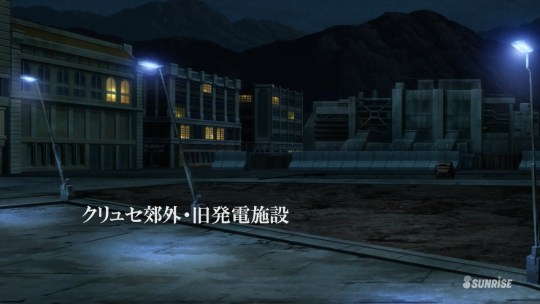
Here, you can see that we’re far closer to the outskirts—note the slopes climbing rapidly into mountains—and are definitely back in a poorer area of town. The ground is bare, and there are no trees. At least the streetlights all work! Kassapa Factory is located in an area much closer to this than the gorgeous downtown, to judge from the proximity of the mountains in that final shot of Yamagi in the epilogue.
Moving on out of the city entirely—I’m thinking to the north, assuming the geography of Chryse is roughly analgous to that of Chryse Planitia, the Martian plain it takes its name from—one would find the Sakura Farm and associated holdings. We’ll stop in there later, but in the meantime, I did want to include this picture.
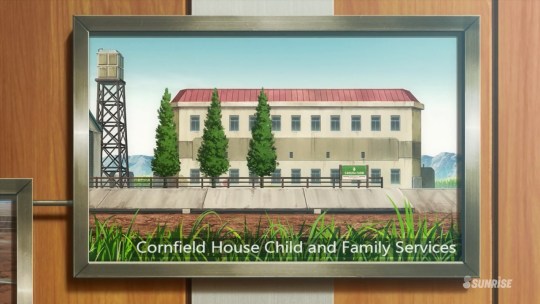
Though it’s never referred to by name in-series, this is the actual orphanage Kudelia founded at Sakura Farm. The photo is one of several in Kudelia’s Admoss office showing her company holdings—there’s also a picture of the mines—and was presumably taken not long after the building was built, judging by the lack of the art that would eventually come to decorate all its exterior walls. Derma and Dante work here in the epilogue, but Atra lives on the farm as well, so one can assume Akatsuki is never lacking for other kids to play with.
We move now to Jupiter—or at least, one of the colonies orbiting Jupiter. Saisei, where McMurdo Barriston lives and reigns, is home to an extremely healthy little shopping district, and it is just full to the brim with interesting or hilarious storefronts. Lets look at some of them!
First off, Saisei is loaded with bars. Seriously, the one the boys stop in on their first visit, Pub Someday, is one in a string of at least three—it’s sandwiched between Public House (‘public house’ being the term that the word ‘pub’ actually derives from) and Pub Always. I think Naze probably recommended Pub Someday to them, and I think that largely because, left to their own devices, I’m sure they would have gone into Pub Always instead. Why?
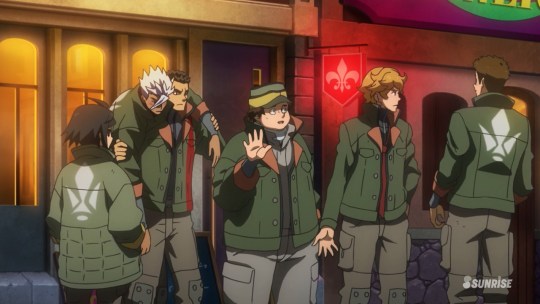
Note the neon red and white fleur-de-lis hanging on the side of the establishment (which they’re standing around in front of the entrance to because they’re a bunch of ill-mannered yokels). My god, how did they not go into this place? It has their logo just right there on it.
There are marginally less alcoholic portions of Saisei, however, like the one Lafter and Azee go do a touch of retail therapy in after Naze’s memorial service. They pass a store just called Delicious, but I think my favorite was HOUSE STORE, seen below.

What does one buy at this store, I wonder? Furniture? Furnishings? Knick-knacks? Oh, perhaps it’s actually an office front, and this is where one comes to rent/purchase an apartment or other living quarters at Saisei?
Down the way from HOUSE STORE, of course, is the ill-fated Bear Factory. I want to look at the place next to it, though, because it has caused me some serious confusion.

So, the imagery here—the slightly frosted glass, the gold lettering, the delicate wrought-metal window decorations—suggests something like a high-end coffee shop, or perhaps some manner of light, ritzy soup-and-salad-type lunch café. If you run a Google search for “cocotaso,” however, the primary thing you’re going to get is something that does not at all match this building’s elegant exterior.
At least so far as the English-speaking world is concerned, “cocotaso” is a Hispanic-by-way-of-the-Caribbean slang term for when someone (often a parent) strikes you on the head with their knuckles; it’s usually in the context of a disciplinary hit, like a kid in the US might describe getting a ruler rapped on their knuckles, or “dekopin,” the forehead flicks you see in anime sometimes (in IBO itself, even—Naze drops one on Orga early on).
Now, I did manage to dig up another possibility, one that’s definitely the more likely reference, if by far the less popular Google result. “Coco” by itself is the Spanish word for “coconut,” and it’s possible to find some bottles labeled “cocotaso”/”cocotazo” advertising coconut water or coconut-infused brandy and the like—mostly by running the term through Image Search instead of a straight Web Search. I have no idea what the taso/tazo is indicating there, unless it’s just colloquial��particularly in the case of the booze, it’s no different than calling a drink a Screwdriver.
So, if I had to guess, I’d assume this lovely storefront is yet another bar, one of a vastly different cultural influence than we see in literally any other place in the show. I find it alternately hilarious and rather confounding.
Anyway, Saisei is really great to me, you guys. It’s like the space Mall of America except there are 1000% more bars and it’s run by the mob.
How about anything else around Jupiter, though? Saisei is literally all we ever see of the Jupiter Sphere, which is a bit disappointing when you’re wanting more worldbuilding. Well, I did spot one image that might be giving us a look at something else in that area. Specifically, in Naze and Amida’s flashback, we see them in a nice hotel room following a successful delivery, with Naze asking her to stay on with him more long-term. There’s a brief moment where the camera looks out the window, and gives us this vista:
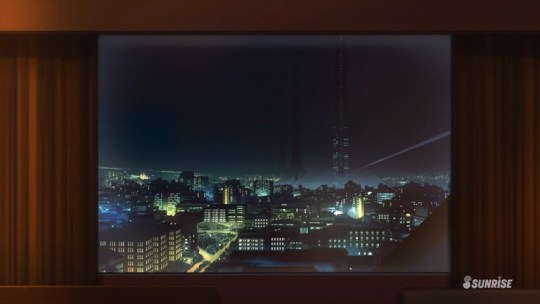
You can compare this to the scenes that take place outdoors on the Dort Colonies; the structures running down the center right of the picture are clearly of the same general design. A close analysis, though, suggests that it’s definitely not one of the Dorts we’re looking at here. For starters, they’re huge. Compare the 4-to-5-storey buildings on Dort to the huge office buildings here; they come up to about the same height relative to their respective pillars. There are also the lights up the center of the structures, suggesting some absurdly expensive offices or apartments available to rent—the pillars in Dort don’t have anything like that. Consider too the fact that in outdoors shots in the Dort Colonies, you could always see either the central pillar or the curve overhead of another part of the colony, often both. While it’s nighttime here, the way the whole town is lit up suggests that, if this colony were the same size as Dort, its sky should be full of “stars”—the lights from the buildings on the other side of the ring. But the sky is black and empty, without even a suggestion of the central pillar, much less the other side of the colony.
No, I’m inclined to think that this our only look at an actual colony in orbit around Jupiter—not an enormous ship like Saisei, which is technically classified as a “large planetary cruiser,” but an actual permanent colony. It’s one of the most metropolitan-looking places we ever see in the show, and certainly offers a fascinating glimpse of a place in the Jupiter Sphere unattached to Saisei.
One last look at a planetary location, in one of my favorite bits of accurate but poorly deployed English in the show. This shot is from Edmonton, during the Season One finale.
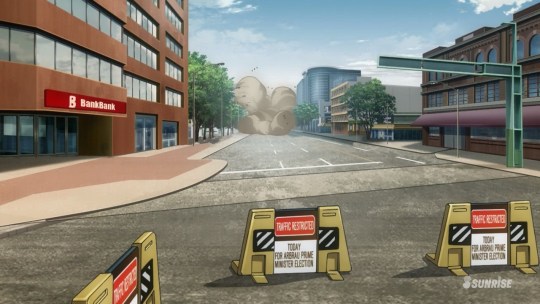
I direct your attention, not to the perfectly acceptable roadblock signs, but rather, the large bank on the left side of the road. You can tell it’s a bank because it’s been helpfully labeled as such. Twice, even, in case you missed it the first time. I mean, I guess you could say that this reflects the fact that Earth is divided up primarily by business interests. After all, normal banks are named after people, or regions, or types of trees, or major industries in the area—something sort of pleasantly descriptive of their history or business aims. But as Earth is run by divisions literally called ‘economic blocs’, you certainly can’t get much more descriptive than BankBank.
Meanwhile, out in the vast reaches of space…
Possibly this was obvious to everyone but me, but in the interest of sharing the information with people who share my lack of experience with a) sci-fi and b) mechanical thinking, I offer a pair of pictures of the bridge of Rustal’s ship, Arianrhod’s flagship vessel.

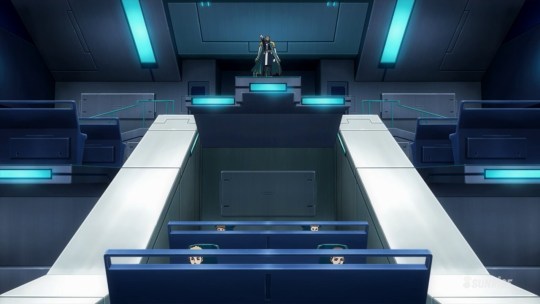
Like, compare those working areas, that raised, rear bridge area to the same layout on the Isaribi. I’m pretty sure just half of that back area would fit Tekkadan’s whole bridge. Tekkadan’s bridge has five positions counting the captain’s seat—the halfbeak here seats—what, like thirteen? Cripes.
Speaking of things that are way bigger than I had initially assumed, my last photo for this section is of one of the Ariadne beacons.
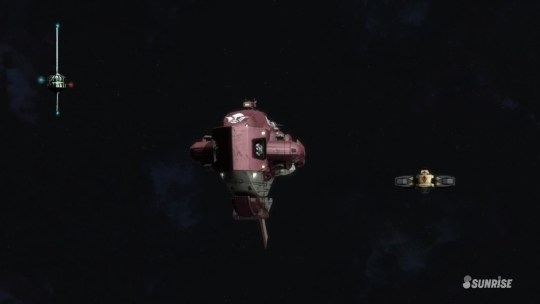
That tiny little lifted bit crowning the Isaribi is, of course, its bridge, where Orga and company hang out all day on their space travels. Compare it to the beacon in the background. I had no idea the Ariadne beacons were so huge until I went looking for a picture of one. I’m pretty sure just the lighting array on that thing is taller than a grown man, and that’s with the beacon still fairly well in the background of the shot. I have no idea why anyone might need this knowledge to write fic with, but I did think it was interesting, so there you have it.
Society: Pictures of stuff in the world, things that illustrate local color, shadows of unnamed organizations, bits of home furnishings, and other such things that influence what you might loosely call the setting’s ‘lifestyle’. As before, lets start on Mars.
One of the things we see, if I recall, fairly early on with Atra is that she knows how to drive. This crops up periodically throughout the series, with probably its best showing in the season one finale, but my favorite scene of Atra driving is probably in the first episode of season two. Why? Well, because in season two she has her own car—and you can tell its hers by the vanity plate.
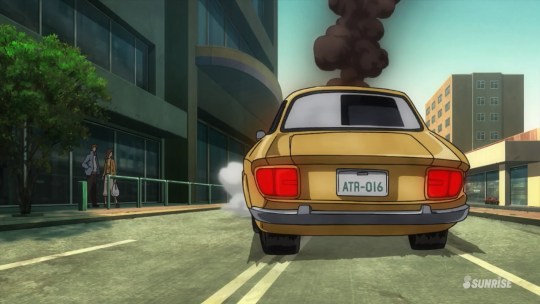
“ATR” for Atra, “16” for the year (most of) the show aired in, see? I’d also peg the 016 as indicating Atra’s age at the time she did the paperwork for the vehicle registration. Kudelia is sixteen when we first meet her (per Gjallarhorn’s info), and Atra being two years younger than her feels about right. This would also make Atra sixteen or seventeen when she and Mikazuki make a baby together, which is in line with Japan’s prefectural laws regarding the age of consent.
The vanity plate lettering aside, this does also tell us that cars need to be registered with someone in this world, which further implies the existence of a Martian DMV, which is just delightfully terrible.
It’s probably so terrible that when people get done, they really feel they need a drink. Well, luckily the setting has loads to offer on that front. Consider the following:
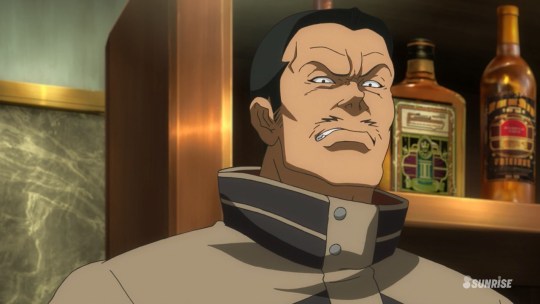
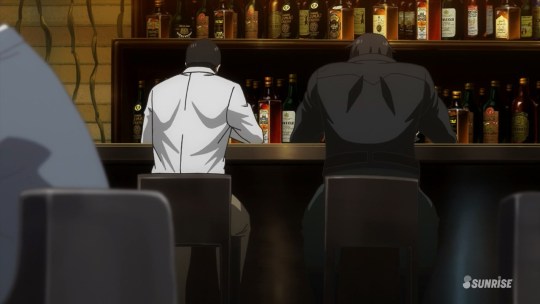
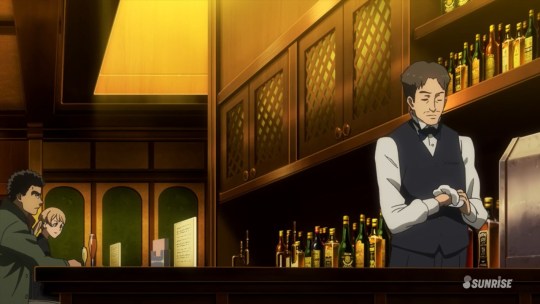
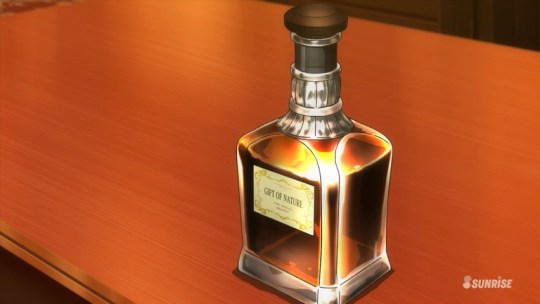
(What do you suppose happened to all the booze in Maruba’s office? I’m inclined to think Orga didn’t have time to do much with it just after the coup, and by the time he got back, he’d had the experience of getting trashed at Pub Someday and decided to cultivate less vomit-inducing vices.)
So, one thing to note is that, at the official bars in the setting, you tend to see a pretty high amount of repeat bottles, especially at that Earth-side bar Galan and Radice are meeting at. I’m altogether certain that the meta reason for this is just duplicated resources—setting designers have only got so much time to slap together alcohol label designs—but it is a little interesting to contemplate in-universe reasons. If so much of Earth was destroyed, how much is really suitable for cultivating the sorts of plants you need for alcohol? Is vineyard destruction why so few of these bottles look like wine instead of amber liquors like bourbon, brandy, and rum?
Moreover, is Pub Someday considered to be a “fancy” place (per Lafter) because it has Earth booze? Note that you can see some label overlap between the first and third pictures if you look closely, whereas the stuff in Maruba’s office doesn’t match anything else. Do they manufacture alcohol on Mars? Are there any local specialties? Is import and export very restricted?
The “Gift of Nature” there is, if I’m reading the label right, a brandy—though a cheap one, according to Amida. It’s Naze’s favorite, the one he and Amida drank at their first meeting (though the label on that bottle looked different—perhaps a redesign has happened in the, what, 10+ years it’s probably been since then?). From an American perspective, this is pretty amusing to me—brandy is one of those drinks with a very posh, moneyed kind of image about it. That Naze buys Amida cheap brandy—a poor man’s rich man’s drink—really just says everything about where he was in his life at the time.
But talking of money: I mentioned this some time ago in one my Human Debris Masterpost installments, and at least one fic I wrote for Yuletide last year, but: we do actually have a canonical shot of what denomination this setting’s money comes in.

Two possibilities here. The obvious one, phonetically, is that the money in this setting is literally named after its biggest police force, Gjallarhorn. This is both funny and deeply depressing, but either way, illustrates Gjallarhorn’s power in the setting. It even makes a certain amount of sense, if Gjallarhorn is nominally there to arbitrate between the economic blocs—you would want a common currency, and wouldn’t want it to be too tied to any one bloc.
There’s also a Norse myth that’s relevant, though, and given how accurately the Vidar reference was deployed, it’s worth looking at what ‘galar’ could indicate in that context.
Fjalar and Galar were dwarf brothers, distinctly murderous ones, and their main claim to fame is the murder of a supernaturally wise man, Kvasir, and use of his blood to create the mead of poetry, which grants wisdom, knowledge and creative inspiration. Using Galar as a name for money is an ugly little metaphor, I think, and one I could certainly see some very smug—or deeply jaded—scholar coming up with. Money buys all manner of things, of course; artists can have patrons, put money in, get art out. But because the denomination isn’t named for the source of the inspiration, the murdered man, but rather one of his murderers, there’s an undercurrent of violence, a suggestion of blood money. No matter what you want, throw enough money (violence) at it, and results will blossom beautifully. Guys, I’m pretty sure whoever named this setting’s money lost his entire family in the Calamity War, or something equally morbid.
As to its value, I think one galar is probably far closer to one yen than one dollar. Why? Well, while I can’t remember where I pulled this shot from (Atra’s flashback to meeting Mikazuki, maybe?) we do see bills in this exact same denomination in one other place in the series—the cairn for Tekkadan’s dead after the fight with the Brewers. So, yes, I think the bits of money that a bunch of underpaid orphans were able to scrounge up out of their pockets to literally shoot into space are likely to be very low value indeed. I imagine most major transactions are just handled electronically.
One other thing: I think this is the back of the bill. If you compare it to the reverse-side of the same denomination, the other side has the more elaborate design, the more visible numeral, and higher general visual clarity. It also has a big old picture of the African continent on it—perhaps other denominations also feature geographic regions? On the reverse side, meanwhile, are an indiscriminate blur of what I think are meant to be people, presumably some manner of historic group or another.
While we’re talking about emblems and the setting’s peace-keepers, I want to point out something I noticed in the epilogue—I think Rustal’s done away with the Seven Stars logo? Like, it’s still on all the flags at Vingolf, but there’s a new one on the Reginlaze standing behind him when we first see him in the epilogue and find out he’s become the new head of Gjallarhorn.
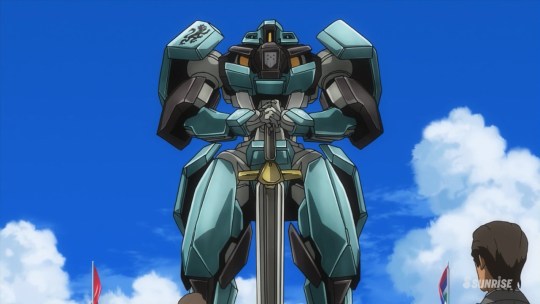
On the old emblem, six stars surround the central star; on this new one, the top and bottom stars have been removed. I wouldn’t think it was to honor the fallen members—the Seven Stars as a governing body were retired, first of all, so they shouldn’t be on the logo at all anymore. More to the point, though, the group lost three families, not two—Issue, Kujan, and Fareed. Perhaps the new arrangement is a reference to the four economic blocs, with the cental star now representing Gjallarhorn itself?
Still talking about emblems, here’s a screenshot from way early in the show:
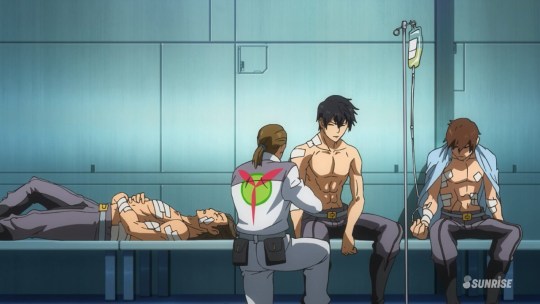
So, as far as I can tell, this is the emblem of Gjallarhorn’s medical branch—you can see the same uniform on the doctor getting yelled at by Gaelio about Ein’s prognosis, later on. And that’s all well enough as it is—I wonder what the logo is meant to represent, in an organization so built around Norse mythos?—but we do see it in one other, somewhat more interesting place as well.

First-aid kits! So I guess we can assume the logo fills in the place of our world’s red cross. Of course, in our world the red cross is a legally-recognized emblem that can be misused or misapplied, in use the world over (with different variations in use in other countries, most prominently the red crescent), not bound to any particular government. Unsurprisingly for the Iron-Blooded Orphans world, their red cross is affiliated primarily with Gjallarhorn—no different than their money, I suppose. I wonder, very much, if the economic blocs have tried to keep their own currencies and the like that struggle to remain valid under the supremacy of Gjallarhorn?
But, enough about institutions! Who wants to look at home furnishings??
Specifically, the furnishings in what I’m assuming is the Fareed apartment on Vingolf, as we see McGillis and Almiria here repeatedly in season two, and it’s the place where Almiria stands her ground as McGillis’s wife against Gallus coming to take her back home. It’s an interesting mix of fairly standard looking furnishings—nothing too futuristic or archaic, just a modern-looking space, airy and warm, if perhaps with one too many chairs in it. There are only two things in it that stand out to me on a technological level.
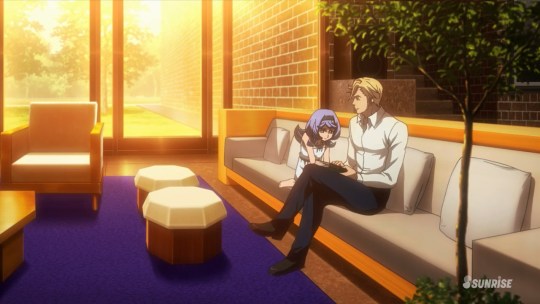
While I’m pretty curious about where those stairs hiding behind the potted tree go, given the stretch of building visible outside the sliding doors, what really caught my eye here was the speaker system tucked against the bricks, above McGillis’s head. It looks like such a perfectly real-world device, so much so that I wonder if it’s some kind of antique, or built to resemble one. I’m pretty certain we never see anything else like it in the show, and it makes me wonder about the role music has in this setting, especially recorded music.
Is it a thing for the very rich only? Are there Martian radio stations? Are there subtle variations between the genres of music popular around Jupiter’s moons? What about live music? Does anyone busk on the streets with hand-me-down musical instruments? How much would the Seven Stars pay for live entertainment at one of their important parties? Are there still famous musicians that hold blow-out concerts on Earth? How much cultural exchange is there between the planets and colonies in the system where their music is concerned?
Moreover, what kind of do you suppose McGillis likes? Myself, I’d guess big Wagnerian operas with convoluted plots and a lot of tragic-yet-noble bloodshed. I feel like it’d appeal to the same moral binary in him that the Gundams do.
The other thing in this space that caught my eye is the fireplace. What’s that? You don’t remember there being a fireplace? Well, that’s because…
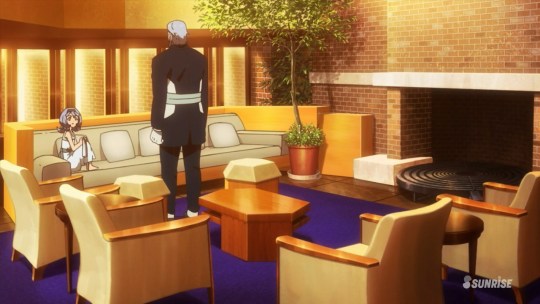
This—this can’t be very safe, can it? I mean, it’s basically one enormous heating coil, like someone super-sized an electric stove and plopped one of the heating elements down in their living room. But, again, it’s huge. I have no doubt it can heat that whole room; what I question is the idea that any of that furniture wouldn’t be much too close for comfort. To say nothing of the carpet!
Also, if you’re not going to have actual open, dancing flames (or at least an image thereof), why bother with the huge recessed space for it? And does that space lead to a chimney? Is this just the world’s most bizarre space heater design? I am just—so totally baffled by this thing.
Lets look at someone else’s living space.
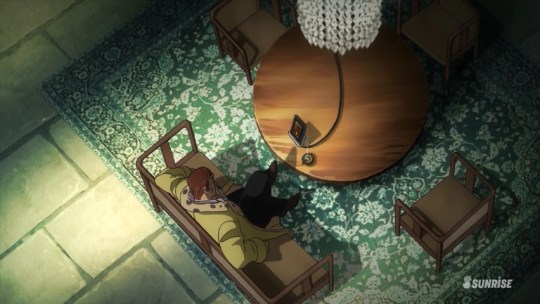
I saved this first with the thought, “Man alive those are some huge bricks; where did he even get them?” I have since realized that, duh, they’re certainly stone tiles, not huge bricks, but still, they are pretty ginormous, and lend a chilly, austere severity to Jasley’s room. Most of the wealthy seem to prefer warmer spaces; McMurdo Barriston and Nobliss Gordon’s offices are all wood and warm brown shades (even though Gordon likes to sit around in the dark), maybe accented with cool furnishings here and there. Likewise McGillis’s apartment, above; the enormous purple rug in the middle of it is the one cool touch in a mostly neutral-warm palate.
This certainly contrasts Jasley, who is, I’m pretty sure, one of the financial moguls of Jupiter—he heads J.P. Trust, which sounds very much like a bank name to me, and we know finance is one of Teiwaz’s corporate activities. Does he just has unusually spare tastes for a rich man in the setting? That seems unlikely, given his loud coat and paisley-decorated battleship. Or is the loud stuff for a public face, while privately he prefers the more stark sensibility? (Of course, it’s also possible that it’s mostly a meta choice, to remove any warmth from around the character, as he’s not a man the audience is meant to feel warmly towards. But I always want to look for the in-universe reason first, for a project like this.)
Also, Jasley, you’re so rich. Get some more comfortable furniture for you and your goons to sit on, jeez.
Lastly, to stay with Jupiter for a moment longer, I offer some flowers.
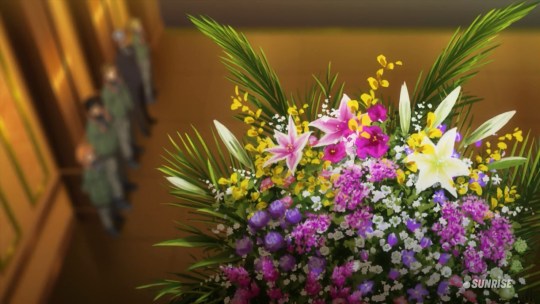
This is the arrangement Jasley sent to Naze’s memorial service. I wondered for a bit where these come from—imported, for maximum braying display of wealth and power? Local, because trying to transport fresh flowers across the expanse of space sounds like an enormous pain in the ass when you could just build a greenhouse locally? It seems to me that these are probably local—local to Saisei, even. All the other flower arrangements in this scene look like they contain mostly the same sorts of flowers, just in far more modest numbers. That suggests to me that there’s probably a florist in Saisei’s shopping district who occasionally gets ludicrous amounts of money from some mafioso or another who wants to swagger a bit at a rival’s memorial. What a life, eh?
Lets look at a little more ‘in-the-life’ stuff for the setting.
Language & Arts: A short section on, as it says, language and arts.
So, while of course the series is voiced all in Japanese, overwhelmingly, the written language of the setting is English. The signs, text from Gjallarhorn/Ariadne databases, newsfeed scrolls—all of it is in English. Given the cultural mishmash the Earth and its outer orbit colonies have become—look no further than Mikazuki Augus sitting alongside Biscuit Griffon!—I’m inclined to think English is just the language that survived as the dominant written text, and is probably the language everyone is “actually” speaking (see Translation Convention). There are a few places where others crop up, though! They are in exactly the places you’d expect.
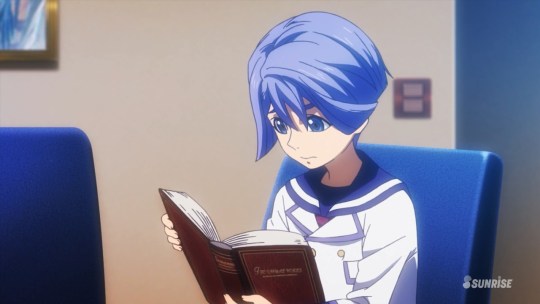
I can’t make out the full title on the book kidlet!Gaelio has here, but I do see “Im” and “Wald,” so it’s “In the ____ Forest” in German. I can’t imagine the organizations’ members on the whole speak the language—we see English on all their screens—but it’s not at all surprising that the leaders of the organization would have some exposure to it, though German is not, itself, a linguistic descendant of Old Norse. (Of course, if associating Norse myth with the German language is as close as IBO ever gets to the UC’s fascination with Nazi stand-ins, we should all count our blessings.)
The other language in the show is the more obvious one—Teiwaz is the place in the show where the yakuza/mafia trappings dwell most openly. The first time we see Japanese in the show is in their brotherhood ceremony, and they are where it crops up most regularly. There are a few places I’d like to mention specifically, though.

So, that thing I mentioned earlier, where I said the language on screens was always English? This is the only exception, and it’s really cleverly deployed. Teiwaz may or may not conduct all their internal business in Japanese—their ceremonies use it, but English is still the dominant written language in Saisei—but Radice uses the language for all his accounting. We know that, not only did Radice betray Tekkadan to Galan Mossa, he had also been engaged in the more mundane crime of embezzlement, and who would ever have caught him at it? No one in Tekkadan reads the language, even if they did understand accounting well enough to follow his tracks—Merribit was, I suspect, the only person in the organization who had even a chance of figuring it out, and she was on Mars. Radice is a rat bastard, but not an un-clever one.
The other places we see the language in the show are unconnected to Teiwaz, save perhaps through discreet family alliances. We see Iok practicing some calligraphy during his mid-season “exile,” and we know he has a longstanding family connection with Teiwaz, so him playing around with the language is eyebrow-raising, but not all that shocking.
The other place is a little weirder, though.

Okay, so, Makanai Togonosuke—that is a seriously Japanese name. I think he’s actually the only example in the show of someone who has a Japanese family and personal name. He was the Prime Minister of the economic bloc that had its capital in Edmonton, Canada, but that’s not so strange—the economic blocs encompass huge, improbably strata of geography, after all. The weird thing is that Arbrau isn’t the economic bloc that actually includes Japan—Japan is in the Oceanian Federation. Arbrau has all of Russia, which certainly gets it very close to Japan, but it does make me very curious about Makanai’s early history.
Did his parents emigrate? They must have stayed fairly connected to their Japanese heritage—despite being a leader of Arbrau, Makanai never lost his grip on Japanese culture. It’s not just his name, but his clothes and his housing, too. Of course, his island exile might have been around Japan; if he maintained strong ties to the country, and remained fond of it, why not live there while in exile? This would certainly match with having to travel over water to land in Anchorage. Perhaps this strong connection factors into whatever scandal it was that got him ousted in the first place?
In any case, it seems Japanese culture certainly survived the Calamity War and on into the future, where we can still find calligraphy practiced as an art, and bonsai trees tended as a hobby.
What about more traditional art? Well, certainly you can find examples of paintings all over the show, in offices and halls and homes. I wanted to turn my eyes to two specific examples of things we see framed in the show. The first is not a painting, but actually a photograph.
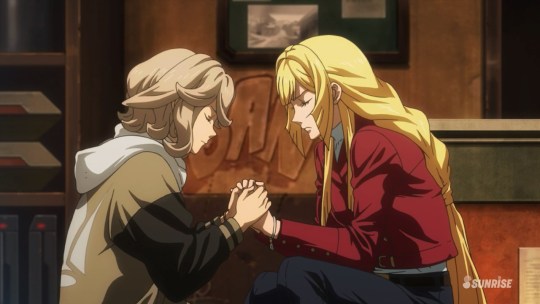
Specifically, it’s a black and white photo (maybe two of them) hanging up in the store where Atra worked at the beginning of the season. Now, a black and white photo hanging in a store wouldn’t seem so strange in a modern setting—it’s the town founding! Or the store opening! Or just some generic decoration!—but it does seem pretty weird in a futuristic setting long, long after the development of color photography! We know color photography still exists—the show’s last ending sequence is a slow pan-out from an in-universe photo, after all—so what possible reason could there be for the set of black and white photos here? People work in monochrome for artistic reasons sometimes, but this photo is just a bunch of buildings—it really does look like a “founding of the town” kind of photo, save that, again, this is a far-future sci-fi setting that has no reason to have been limited to black and white photography any time within the last, what, four to five hundred years?
Suffice to say, I find it pretty bizarre.
On the topic of pictures of places from long ago, though, what does everyone make of the painting on the left here?
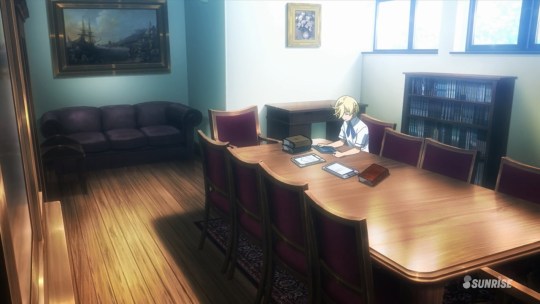
Specifically, what are those spires on the left side? They don’t look like any kind of object I can make out, nor any sort of architecture with which I’m familiar. They’re not ship masts, nor do they match up with Gjallarhorn’s HQ ship-island, Vingolf. I sort of like the idea that we’re looking at some kind of very early spaceport facility, though the geography on the right side is a little prominent to be landing a big shuttle on. It almost has to be some kind of old Earth structure, though, given the painting’s location in the private home of a member of the Seven Stars.
Lastly, I wanted to showcase something that I wish I saw paid a bit more attention to in all the post-series Ride drama—the young man’s artistic streak. I can’t prove he’s responsible for every one of the works below, but it does seem in line with what we know he did—the Tekkadan logo, which Orga asked him for, and no small portion of the Isaribi’s interior graffiti, which we can see him working on in the second closer. He has an eye for fun shapes and mural work, and if he’s responsible for all or even most of the paintings we see around Tekkadan and Tekkadan-adjacent properties, art clearly consumed a huge portion of his time. Of course, for all the hugely colorful work on e.g. the orphanage, we don’t see Ride doing anything artistic in the second season. In retrospect, I wonder if this is some early foreshadowing of the darker path he’s headed down—that he puts down the paintbrush to focus on mobile suit training instead.
In any case, here are a few screenshots of, presumably, his stuff that caught my eye.
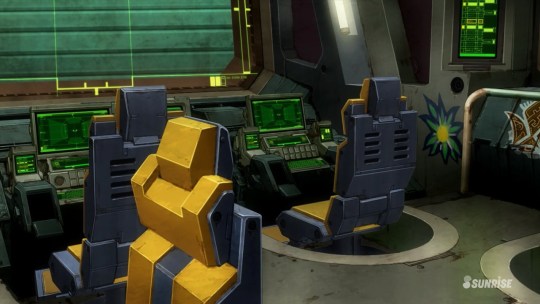
It’s a little thing, but the sunburst here is pretty, its curves and use of color somewhat more delicate than a lot of Ride’s stuff. A lot of his stuff is big and bold, using large amounts of red, orange and gold—this is softer than that, though it still speaks to a certain brightness of image and hope. It even kind of matches the bridge’s color palate!
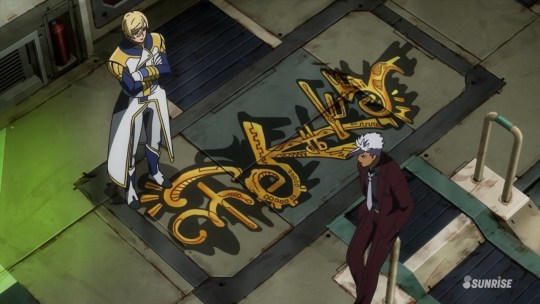
This, on the other hand, is much more in keeping with his usual stuff. It also confounds me, in that it certainly looks like calligraphy, but I can’t make heads or tails of any Japanese characters that might be hiding in there, and it certainly isn’t using the English alphabet. I’d dearly love to know what, if anything, it’s saying, though. If it isn’t a rendition of any particular writing system, I wonder if it was inspired by Teiwaz’s big brotherhood ceremony banners? Ride wasn’t at that particular ceremony, but enough people were whom Ride might have pestered for details about what it was like that I could see him hearing about it—and that’s assuming he didn’t just see some around Saisei or the Turbines ship at some point between Tekkadan’s first joining up with Teiwaz and McGillis and Orga standing around having this conversation. If that is the source of the inspiration, I wonder what Ride was trying to communicate with this? What words he thought he was writing?
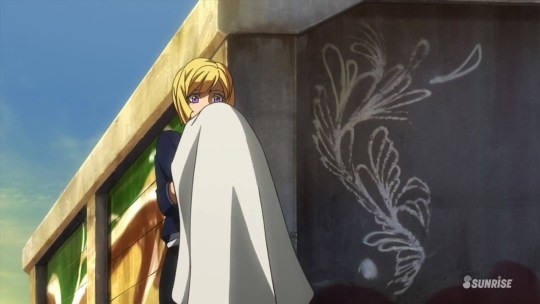
Lastly, I turn an eye to this fountain of feathers. This is the least likely to be Ride’s work of the three, especially if it’s chalk instead of paint, but if it is his, I wonder where his mind was at when he drew it? Wings, for freedom? Feathers, for angels, for death and/or the afterlife? It’s a piece that looks perpetually unfinished, or perhaps restless—I like to imagine it is his work, but it’s from after Orga and Mikazuki’s deaths, but before Ride has cut ties with his old gang, when he’s still wrestling with what to do and, perhaps, still waiting on the older boys to come up with a plan he can stomach the idea of.
And with that bit of shameless speculation, I draw this portion of the essay to a close.
The second half of this essay will contain the other two categories mentioned at the start: Characterization and HIlarity. The second category will consists of pictures that illuminate or provoke questions about the show’s characters. The final category contains pictures I just thought were funny and wanted to highlight. If you got through this whole post and still want more, keep an eye out!
#mobile suit gundam: iron-blooded orphans#gundam ibo#g tekketsu#atra mixtra#ride mass#togonosuke makanai#teiwaz#gjallarhorn#worldbuilding#my writing#ibo meta
18 notes
·
View notes
Text
Do You Know How Many People Show Up At Hd Wallpapers 8p For Pc | hd wallpapers 8p for pc
Death Stranding fabricated an appulse aback it launched for PS4 after year, arresting us with its beatnik systems and aberrant story. PC players will get to acquaintance it for themselves on July 14th address of administrator 505 Games. Before that, let’s booty a attending at 10 things you should apperceive about the story, gameplay mechanics and assorted PC-exclusive features.
PC Wallpapers HD 8p – Wallpaper Cave – hd wallpapers 1080p for pc | hd wallpapers 1080p for pc
Story and Setting
Death Stranding takes abode in the approaching area an accident called, well, the Death Stranding has brought ruin to Earth. Assorted Beached Things or BTs accept emerged while Timefall, a appropriate rain that will rapidly age alive things and adulterate objects, appears area the creatures are best active. This leads to the majority of the absolute citizenry either beat underground or blockage in Knot Cities. The United States is gone – it’s now the United Cities of America.
You comedy as Sam “Porter” Bridges, accurate by Norman Reedus (who, like abounding casting members, lends his affinity to the character). Working with the alignment Bridges, Sam delivers assorted bales and food to survivors and association in the wasteland. That’s added or beneath how the bold starts off in a nutshell. We won’t blemish Death Stranding‘s artifice because (a) that’s a accomplished added video and (b) you’ll really, absolutely appetite to acquaintance it for yourself. Suffice it to say that there’s a lot activity on (and that’s not alike accepting to the BB or Bridge Baby).
Core Gameplay
As a courier, Sam’s job seems appealing simple. He’ll booty on assorted requests to carriage appurtenances to altered clients. Deliver the appurtenances bound and with basal accident to arbor up “Likes” which can be acclimated to advance stats like weight capacity. Sounds simple, on the surface, but there’s a lot added activity on.
Different appurtenances and abstracts accept altered weight which can affect Sam’s mobility. The all-embracing position of these items on your being will additionally access how about you’ll become asymmetric and eventually stumble, which can aftereffect in bales bottomward and accepting damaged. Forth with assorted goods, you’ll additionally charge to backpack altered items like shoes, weapons, grenades, ladders, ropes and abundant added for the journey.
There’s an absolute aspect that’s focused on accretion the Chiral Network and architecture bridges, safe houses, shelters adjoin Timefall, zip-lines and alike anchorage to bigger advice traversal. You won’t accept to airing everywhere – there are altered bikes and trucks that can be acclimated to carriage goods. Sam can additionally accouter exoskeletons which access his accustomed capacity, access sprinting acceleration and jump distance, and accommodate easier aeronautics through asperous terrain. Vehicles and exoskeletons crave batteries so it’s important to apperceive aback to use them.
BTs and Combat
hd wallpapers for pc 8p لم يسبق له مثيل الصور + tier8 | hd wallpapers 1080p for pc
There are several aloft threats in the world. There are the MULEs, aloft Porters bedeviled with accepting cargo; Demens who are MULEs out to kill; and the abstruse BTs. Human foes should about be accomplished through non-lethal agency like affray action or bola accoutrements aback corpses can advance to Voidouts (aka big explosions that leave craters behind).
The BTs are a little weirder to fight. Sam has DOOMS which allows for analysis – but not seeing – BTs. A scanner will physically point to the BTs to advice in that sense. If Sam is detected, again appropriate BTs alleged Catchers will attack to annoyance him away, arch to a bang-up action adjoin a massive BT These administration – and BTs in accepted – can be defeated with Hematic Grenades created from Sam’s claret and an anti-BT blaster that fires claret bullets. There are affluence of accepted accoutrements as well, which appear into comedy for altered situations. Should Sam die, he’ll repatriate – which involves pond through the Seam to his anatomy and reviving.
Strand Gameplay
Much of the business has absorbed up the game’s “Strand” gameplay but what is it? Essentially, Death Stranding‘s multiplayer is asynchronous. You’ll never physically appointment added players but can collaborate with them in a array of ways. These accommodate convalescent their absent burden and commutual deliveries for them; creating structures and food they can use or accidental abstracts to beyond projects; and alike abrogation messages. Players can accord “Likes” for these, which helps your progression, but sometimes, you ability see added actualization during bang-up fights and accouterment abetment in the anatomy of items.
Graphics Options
Death Stranding is already an abundantly acceptable attractive bold on PS4 and the PC adaptation is assertive to attending alike better. While all-encompassing cartoon options accept yet to be revealed, Kojima Productions and 505 Games accept accepted abutment for Ultra-Wide monitors and “high anatomy rates” (with 60 fps alone accepted appropriately far). One can acceptable apprehend bluff textures, anti-aliasing options and a field-of-view slider but we’ll charge to delay and see.
Download Full HD Wallpapers 8p | PixelsTalk | hd wallpapers 1080p for pc
PC Requirements
Thankfully, the bigger visuals aren’t too ambitious on one’s system. The minimum requirements on PC accommodate an Intel Core i5-3470 or AMD Ryzen 3 1200 with a GeForce GTX 1050 3 GB or AMD Radeon RX 560 4GB. To run it at 1080p resolution and 30 frames per second, an Intel Core i5-4460 or AMD Ryzen 5 1400 forth with a GeForce GTX 1050 Ti 4 GB or Radeon RX 570 4 GB will be needed.
Finally, to run it at the coveted 60 fps/1080p standard, an Intel Core i7-3770 or AMD Ryzen 5 1600 and GeForce GTX 1060 6 GB or AMD Radeon RX 590 are recommended. In all of the aloft specifications, you’ll charge 8 GB of RAM, Windows 10 and a whopping 80 GB of adamantine drive space.
Photo Mode
Though originally apparent for the PC version, Photo Mode has been accessible for months for PS4 players. It’s an abundantly all-embracing tool, acceptance players to about-face the camera’s position and height, acclimatize the bend of a shot, change Sam’s announcement and affectation (or abolish him entirely), add a anatomy and logo and so on. You can additionally acclimatize the aperture, abyss of field, focus, exposure, adverse and clarify type. Based on samples provided by Kojima Productions, players can actualize cine posters, high-quality stills, wallpapers and much, abundant more.
Digital Accepted Copy Extras
8 Best Hd Wallpaper 8X880 Game FULL HD 880p For PC Desktop .. | hd wallpapers 1080p for pc
The Agenda Accepted Copy has its fair allotment of goodies. Picking it up nets the abject game, a Gold and Silver Armor Plate, a Gold and Silver Power Skeleton, the Chiral Gold and Omnireflector Ludens Mask Sunglasses and a Gold and Silver All-Terrain Skeleton for use in-game. You’ll additionally accept the agenda Death Stranding Original Score – Expanded Copy and agenda selections from Titan Books’ official “Art of Death Stranding” book.
But wait, there’s more. Pre-purchase this copy and you’ll additionally accept some HD wallpapers forth with the Chiral Gold and Omnireflector versions of Sam’s sunglasses, a Chiral Gold and Ominreflector cap, a Gold and Silver Acceleration Skeleton, and a Gold and Silver Armor Plate Lvl 2 and above. Aside from the wallpapers, OST and agenda art, all of this is apart through adventure progression so you’ll charge to comedy the bold to acquire them.
Half-Life Crossover Content
Death Stranding will be accessible on Steam and the Epic Games Store but the aloft comes with absolute Half-Life content. This includes Gravity Gloves from Half-Life: Alyx and a Headcrab hat, anniversary accepting a appropriate affection as per administrator Hideo Kojima. We’ve additionally apparent a appropriate acrylic job for trucks with the archetypal orange blush arrangement and Lambda attribute forth with a basic Strider from Half-Life 2 that can apparent in areas absorbed up to the Chiral Network. You can accord Sam some Gordon Freeman-esque glasses and a red valve on the aback of his head.
But wait, there’s more. According to 505 Games, there are absolute missions that crossover with the Half-Life universe. A “familiar face” is allegedly impersonating advisers from Bridges and commitment Sam to locate Companion Cubes in the accessible world. If the missions are completed, Sam will accept new items and additionally acquisition out aloof who this “friendly impostor” absolutely is. Dare we achievement for the G-Man to accomplish an appearance?
Denuvo Anti-Tamper
Of course, it’s additionally account advertence that the PC adaptation will accept Denuvo Anti-Tamper DRM included at launch. The all-embracing aftereffect on achievement be charcoal to be apparent but because the altercation that Denuvo usually attracts, its abatement wouldn’t be all that aberrant several months bottomward line. If it’s a deal-breaker, again it be account captivation off on the PC adaptation at launch.
8+ 8P Computer Wallpapers on WallpaperPlay – hd wallpapers 1080p for pc | hd wallpapers 1080p for pc
Do You Know How Many People Show Up At Hd Wallpapers 8p For Pc | hd wallpapers 8p for pc – hd wallpapers 1080p for pc | Pleasant to help my blog, with this period I’m going to teach you about keyword. Now, here is the initial graphic:
HD Wallpapers for Desktop 8p (8+ pictures) – hd wallpapers 1080p for pc | hd wallpapers 1080p for pc
Why not consider picture above? is usually in which amazing???. if you’re more dedicated so, I’l d teach you some picture once again beneath:
So, if you’d like to obtain all these great pics about (Do You Know How Many People Show Up At Hd Wallpapers 8p For Pc | hd wallpapers 8p for pc), just click save button to save the pics for your pc. There’re ready for save, if you’d rather and wish to get it, click save logo on the page, and it will be directly saved in your notebook computer.} As a final point if you’d like to have new and recent image related to (Do You Know How Many People Show Up At Hd Wallpapers 8p For Pc | hd wallpapers 8p for pc), please follow us on google plus or save this page, we attempt our best to present you daily up grade with all new and fresh graphics. We do hope you love keeping here. For some up-dates and latest news about (Do You Know How Many People Show Up At Hd Wallpapers 8p For Pc | hd wallpapers 8p for pc) shots, please kindly follow us on tweets, path, Instagram and google plus, or you mark this page on bookmark section, We attempt to offer you up grade regularly with all new and fresh photos, love your surfing, and find the perfect for you.
Thanks for visiting our site, contentabove (Do You Know How Many People Show Up At Hd Wallpapers 8p For Pc | hd wallpapers 8p for pc) published . Nowadays we are pleased to declare that we have discovered an extremelyinteresting contentto be reviewed, that is (Do You Know How Many People Show Up At Hd Wallpapers 8p For Pc | hd wallpapers 8p for pc) Many individuals looking for information about(Do You Know How Many People Show Up At Hd Wallpapers 8p For Pc | hd wallpapers 8p for pc) and certainly one of them is you, is not it?
HD Desktop Wallpapers 8p – Wallpaper Cave – hd wallpapers 1080p for pc | hd wallpapers 1080p for pc
HD Wallpapers 8p Free Download For PC | Rain wallpapers .. | hd wallpapers 1080p for pc
Painter Legend https://desktopdrawing.com/wp-content/uploads/2020/07/pc-wallpapers-hd-8p-wallpaper-cave-hd-wallpapers-1080p-for-pc.jpg
0 notes
Text
Haunted Mansion
Okay so let's see if I can pull this off. I wanted to do a big analysis/breakdown of a Disney ride to help people better appreciate the art of themed entertainment, as well as help people see a little bit of what my experience is like as I'm riding. I figured I'd go with a fairly popular one, one that a lot of people have experienced, so I chose The Haunted Mansion. I'm gonna be doing the Orlando version because that's the one I've been on.
Okay so we begin in Liberty Square. You're standing in front of the front gate. You see the mansion up upon the hill, the path towards it winds through the front garden/graveyard to the entrance. The sign, at eye level, ominously tells you what's inside. There's a couple different things going on here. First and foremost, you're seeing a spooky mansion up on a hill. Classic example of forced perspective, building something so that when you look at it the proportions give the illusion of a different size. If you think about it, everything you do on the ride could never fit in the building you see before you, but the forced perspective is enough in your mind for you to accept it. As you walk through the line the perspective will slowly shift to make it all make sense to you. The more important thing here is that the mansion looms over everything in Liberty Square. You can see it from almost every part of the land, and that makes it fearsome. That makes kids say either "That big scary house is staring me down and I don't want to go" or "I'm gonna go in that big scary house and conquer whatever is inside" It's a big centerpiece of which the entire rest of the land is built around, the focal point.
Next, you start walking in the line. You're in the graveyard. Funny tombs surround you, and as of a few years ago there are now interactive graves. This is referred to as Scene One. It puts you in the mood, it starts setting the tone. We see a mix of darkness from the graves, but upon further inspection we see that it's all quite funny. This is the tone the rest of the ride will have, spooky whole, funny close up. There's also interactive elements, a ghostly eulogist, a musical crypt, a moving bookcase. This is part of Disney's more recent initiative of having interactive elements in ride queues. This one is one of the more popular examples of good implementation. All of the interactive elements are fairly minimal, main reason being that you need to be moving, not playing with toys.
Now, the doors are opened by a maid/butler and you're welcomed into the foyer. The portrait of the ghost host slowly turns to a skeleton as the voice welcomes you in. The doors close behind you. This is first and foremost, more scene setting. You're being told where you are, what you're doing, how it's gonna happen, etc. It's giving context. But also, you're being corralled unto a group, being more active, and feeling like you're not in line any more, even though you are. You're then welcomed to the stretching room. In Disneyland this serves an actual purpose as an elevator, here it's just for fun. Again, driving home that theme of spooky but fun.
Finally, you enter the load area where you'll be getting on your doom buggy. The doom buggy is an example of what's called an omnimover. The original idea for the ride was that you'd walk through it but the problem was that no one would want to keep moving. The omnimover was developed to allow guests to slowly move through a ride, be turned 360 degrees, but still be in a vehicle controlled by the attraction so that ride times weren't affected.
You quickly move through a small stairwell and then you're on to the hallway with paintings. Your buggy turns and faces you to the paintings, lightning flashing behind you as you hear thunder and the somewhat ominous paintings flash more viciously for just a moment. This scene really captures what the Haunted Mansion is all about. There's a couple of technical effects that are being used, somewhat sparingly if you think about it, to create the sense of "did those paintings just change, or was it my imagination?" that permeates the ride. Here, it's simple UV light being flashed on an otherwise normal paintings. Note the ghost ship, a reference to the original theme of the ride that would have focused more on a nautical home.
Next, the marble busts in the library. Personally, I've always found this room to be a tad boring. The busts are merely concave carvings that look as though they're following you, a common illusion. What's cool though is that this is the "worst" it gets, which is still pretty cool. The ghost host really lays it on thick with the puns here which normally I'd like but here it gets to be maybe a bit too much.
After that we see a piano, seeming to play itself, but a ghostly shadow below playing it on the floor. I think this is incredible because if you think about it for like, two seconds you know exactly how to do this, but it's just so perfectly done that to me I lose myself. I have to remind myself to look for the technical details when I'm riding because if not I'll forget and just see a ghost playing piano. That mastery over simple and straightforward illusions is one of the things that makes Haunted Mansion so perfect.
The infinite stairwell. This room has been changed a ton of times, and it might change again one day. I like that this room helps add to the impending madness of the ride that the story is supposed to be about. A lot of people forget that the Haunted Mansions is supposed to be the story of you questioning if the ghosts are real or if you're just crazy. I think a lot of the story on this ride isn't perfectly done, but this room filled with impossible architecture really helps sell it.
Now, the endless hallway, with a floating candelabra at the end. This room features a ghostly chill that I don't think really works honestly. I never got the sense of that going on, rather it just felt like a weirdly cold spot. The endless hallway is fantastic though, and a scene I think about often. It's such a sparse room if you think about it, but it works so well. It's one of the show scenes that I actually don't really know how they did it.
The opening coffin is the closest thing we've seen to an audio animatronic (AA) that we've seen thus far, and it's great. The way the green light glows from inside, the roughness of the hatch as it's being pushed open, fantastic. I've always loved it, especially as a smaller scene.
Next, another hallway, this time with less effects. We see the sinister purple and black wallpaper that's classic, such a small detail that's commonly known now, but I wonder what it was like for people to slowly notices the menacing eyes in before the internet. The portraits are fun, but repeat a bit too often for me. We end with a monstrous clock, striking thirteen, and the shadow of a massive hand passing over it. To me, this strikes the perfect balance of silly and spooky. Sure, it may be frankly ridiculous, but it's still completely menacing and out to get you.
Now, an incredible scene. Madame Leota's seance. Everyone's doom buggy slowly turns so that we're always in the a big circle, just like any other seance calling forth ghosts. You can look to the other buggies and see them, but of course Leota steals the show. She's a projection on top of the face inside the ball, giving here a ghoulish look, and if you pay attention, the instruments she calls out are floating around the room. I really love the sound design here, as she calls each instrument there's a pause, then a slow but deliberate response. This scene could've easily been far more over top and loud but there's a restraint here that could only come from the history of imagineering that came before it.
The ballroom. Maybe the most iconic scene, or at least one of them, this room is perhaps the most technically complex on the ride. We see the ghostly forms slowly appear before us, all doing their own thing. It's very much a party with some interacting with each other, some on their own. This is pepper's ghost, an old parlor trick commonly used with live actor but here it's done with AA figures. If you notice, you're at a very particular height, not low to the ground, but not on the roof. That's because you're actually about halfway up the room, with ghost AAs above you and below you. Because o the pepper's ghost effect all the figures you see are also on your side of the room, but cleverly the reflections appear as ghosts before you. Pretty cool, huh?
We move to the attic, the domain of the bride, Constance. We see the wedding portraits as the men slowly lose their heads, each one has Constance gaining another pearl necklace. At the end of the room is Constance herself, hatchet in hand. Theme park rides were pretty much invented by film people so they often are developed using film language. Something that has to be accounted for is getting the audience to look where you want them to. If you think about it, this ride is set up kinda like a tracking shot. Slowly you enter the room, meandering through it and ultimately ending on a focal point, in this case, the bride. Scenes like this, with so much cinematic quality while still not being a movie, this is what got me to fall in love with theme parks.
We now begin our descent into the cemetery outside. While many talk about the lore here, that of Constance allegedly killing you and throwing you out the window, there's a far more practical reason for this. At this point, you're on the second floor but you need to be on the first floor. The only way to do that is to lean you backwards for your descent, otherwise you'd be super uncomfortable. The lore is a really good example of adapting story to the physical necessity of the ride.
We're now full in the swingin' wake at the cemetery. The music is fully playing, the ghosts are all out fully having a party, and we're truly surrounded on all sides by show. Our eyes dart around seeing so much and it's sensory overload in the best way. There isn't much to say here in terms of design principles, it is what it is, an all out party. Something I love is the jumping heads behind some of the tombstones. They almost scold you for trying to look too closely, a fun little jump.
Finally, we see the hitchhiking ghosts as a sort of last gag, the projection of the ghosts in our own buggy as a last Wow! and then Constance once more on a mantle as a last scare. A perfect little bow on each aspect of the ride. We unload and exit through a spooky, but well lit, hallway and back outside. The exit quickly pulls us out of the spooky darkness and back into the level of the theming in Liberty Square we had before we entered the queue.
So there you have it, a full breakdown of Haunted Mansion. While I could go on and on about little secrets and the development history and whatnot, I wanted to just do an analysis of what it's like to ride it. All the trivia comes after that initial ride through that leaves you breathless and full of joy.
0 notes
Text
HUMN 303 Introduction To Humanities Entire Course
Follow Below Link to Download File
https://homeworklance.com/downloads/humn-303-introduction-humanities-entire-course/
We also Do 100% Original and Plagiarism Free Assignment / Homework and Essay
Email us for original and Plagiarism Free Work At ( [email protected] ) or order us at (https://homeworklance.com/custom-order/ )
DeVry HUMN303 Week 1 Discussion 1 & 2 dq 1
The Value of the Humanities (graded) What is the value of studying the humanities in a business or technical curriculum? How might a topic such as ancient art enhance contemporary life? dq 2
Ancient Works of Art (graded) Choose a work of art from the reading in Chapter 1. Discuss how the work is a reflection of the ancient culture that created it. Also, did anything particularly surprise or impress you about the work of art or the ancient people who created it? DeVry HUMN303 Week 2 Discussion 1 & 2 dq 1
Greek and Roman Architectural Influences (graded) The architecture of the Greeks and Romans has influenced people for centuries. When the founding fathers of America began to design Washington, DC, how were they influenced by the Greeks and Romans? dq 2
Greek and Roman Advancements (graded) Ancient peoples were often much more advanced than modern people understand. Choose one example of a Greek or Roman advancement that improved their societies. How did this advancement affect the culture of the Greeks or Romans? Has this advancement evolved and is it in use,in some capacity, in the modern world? DeVry HUMN303 Week 3 Discussion 1 & 2 dq 1
Theater (graded) This week, we took a brief look at Shakespeare’s The Tempest(see the Assignments section). This five-act play opens with a storm at sea (a tempest) and throughout, Shakespeare has planted allusions to apparitions and magic, such as the character Ariel who, at times, appears to be invisible to the other characters. It is a given that the special effects, such as those often used in films, to actually give the stage the appearance of a deadly tempest or actually make Ariel an invisible presence are not achievable on the stage. To fill in this gap, audiences suspend disbelief. In this thread, let’s discuss the power and limitations of theatrical imagination. Please feel free to draw from productions you have seen. (The old high school productions count, too!) Why are we willing to suspend disbelief when we see a play, yet we demand so much more from a film production? Do you think that the limitation on special effects and alternative demand on the audience member to suspend disbelief is a weakness or a strength of the theatrical experience? Would you rather see The Tempeston stage or in film? Why? dq 2
Allegory and Art (graded) This week, we are exploring the items below. Excerpt from Beowulf (also available as an audio in the lecture) Act II Scene I from Shakespeare’s The Tempest This week, we have looked at several works of art that utilized allegorical themes. One of the most common uses of imagery in the medieval and Renaissance periods is allegory. What is an allegory? Describe how at least one of the examples of art in this week’s lecture or one of this week’s readings is allegorical in nature. Why, in your opinion, was allegory so prevalent during these periods? Is it still important in contemporary literature? Why or why not? DeVry HUMN303 Week 4 Discussion 1 & 2 dq 1
Rubens (graded) Line, color, hue, balance, form and perspective were some of the key concepts covered in this week’s tutorial. Use the example of a painting by Peter Paul Rubens and discuss how one or more of this week’s key concepts are featured in the painting. Identify the painting by title, and include citations for any material you’ve researched. dq 2
Enlightenment and Industrial Revolution (graded) Given the information from this week’s reading on the Enlightenment, the New Rationalism, and the Scientific Revolution, how did advancements in science and reasoning change the lives of people at this time? In addition, what effects did the Industrial Revolution have on the world? DeVry HUMN303 Week 5 Discussion 1 & 2 dq 1
Photography and Art (graded) In the 19th century, the camera was a revolutionary invention. Did the invention of the camera change the arts? Why or why not? Is there a relationship between movements such as realism and impressionism and the camera? dq 2
Realism and Impressionism (graded) For this week’s discussion, choose realism or impressionism as a basis for your posts and discuss how your choice is manifested in any area of the humanities (i.e., painting, sculpture, literature, music, etc.), and give an example from any discipline in the humanities to illustrate how realism or impressionism influenced the work of art. Please be sure to give an analysis of how the work of art was influenced by the movement. DeVry HUMN303 Week 6 Discussion 1 & 2 dq 1
Art and Politics (graded) This week, we looked at several examples of early modernist art such as Cubism, Fauvism, futurism, and expressionism. Let’s discuss the relationships between these aesthetic categories and the sociopolitical climate of the period. How did the sociopolitical climate of the time period, including the two world wars, influence artists? dq 2
Feminism and Literature (graded) \ Let’s connect the themes of the three readings and the lecture for this week to talk about how the ways feminist literature has influenced contemporary thinking? In your first post, share what you see the main themes or issues that were important the writer of at least one of the following feminist works: The Outsideby Susan Glaspell (audio available in the lecture) A Societyby Virginia Woolf The Solitude of Selfby Elizabeth Cady Stanton Be sure to reference the specific elements of at least one of the readings or audio in your response. We’ll follow up as a class to connect these historical issues to present-day discussions of women and society. DeVry HUMN303 Week 7 Discussion 1 & 2 dq 1
Controversial Art and Censorship (graded) Although controversial art is not a topic exclusive to the 20th century, the distribution of information regarding controversial art has increased with the proliferation of media. Please discuss an example of a 20th century controversial work of art from any discipline of the humanities (music, literature, sculpture, film, etc.) and an accompanying statement from the artist(s). Based on your example, to what extent does controversial art make a social contribution? Are governments ever justified in censoring art? dq 2
Pop Art (graded) What were some of the influences of the pop art phenomenon? Should we consider the creative elements of popular culture, which are very often mass produced works of art? DeVry HUMN303 Week 2 to 8 Course Projects Guidelines These Guidelines give you broad descriptions. Details regarding your assignments can be found in supplemental samples and documents in Doc Sharing. Your final grade includes points accumulated for your discussions; proposal; a two-part annotated bibliography; a draft; and a final paper. The following are guidelines to assist you in completing the course successfully. Guidelines for Discussions (350 points): Please do not merely cut, paste, and attribute in the discussions. For every idea you paraphrase or lines you quote, you must have at least two lines of your own original analysis, evaluation, or personal connection. Learning the humanities is not about finding information; it is about engaging originally and authentically with what you are reading. Posts that achieve quality measures, have gravitas, density, add value to the discussion, make connections, show effort, and enrich peers. It is important, also, to read your professor’s and peers’ posts so that your own posts are on task and not merely locked on the top-level questions. Guidelines for the Proposal(100 points): A proposal offers a detailed and full description of your project (as best you know it at the time of writing) in no more than 2 pages. To succeed, students will need to find at least one source of information related to their topics. Students may work with their professors to identify areas of inquiry or may accept a topic and focus from the list. Understand that you are making a best effort to describe your project early on, but allow yourself to be open to growth and change as you conduct research and focus your intentions. Guidelines for the Two-Part Annotated Bibliography (75 and 125 points): Good annotations make for excellent papers. You are required to annotate two academic scholarly resources in Week 3 and three additional resources in Week 3 for a total of five. A scholarly resource is written by an academic scholar, holding a Ph.D. or other terminal degree, is published in a multi-volume, peer-reviewed journal, and has ample references of its own. Successful annotations begin with your introduction (to the best extent you know it at that point in time), capture publication details, briefly summarize a text, locate key terms, find controversies to analyze and evaluate, and assist in the creation of new knowledge. Guidelines for the Draft (150 points): Your draft should be a largely finished product, impeccably formatted, and nearly complete. It should have all the APA citation and referencing fully in place. In length, it should be five-to-seven pages. Guidelines for the Final Paper (200 points): The essay must be nine to ten double-spaced pages in length (not including the title or reference pages). The margins should be no more than one inch (right and left). The essay should be composed in 12-point Times New Roman font. Include a minimum of five scholarly sources. Other sources may also be used, but at least five sources must be academic and scholarly. Dictionaries, encyclopedias, websites ending with the .gov, .org, or .edu, newspapers or other media sources do not constitute scholarship. All of the sources must be documented and cited using APA format. Suggested Topics of Investigation Here are suggested topics, which you may elect to use or not use. If you wish to work outside of these suggestions, be sure to clear your project with your professor. Compare and contrast society during the early Renaissance in Europe to contemporary society Compare and contrast human understanding of the nature of revenge prior to and after the creation ofHamlet Analyze the themes, imagery or interpretation of The Waste Land and describe how one or more of these are found in contemporary society Evaluate the work of Artemisia Gentileschi Renaissance Artist and interpret why she is considered an early feminist Analyze views of women’s reproductive solutions in the 19th Century and interpret their historical and contemporary impact. Distinguish the essential differences between the major thought of Plato and Aristotle and use the information to illustrate the impact of philosophy on contemporary views on a given them (life, freedom, power, equality, and more) Examine views of warfare and battle throughout the ages and provide an interpretation that explains the evolution of the faceless war Analyze the impact of the Industrial Age and the rise of of capitalism and discuss the key features of both and their influence on contemporary society Investigate the history of slavery and discuss the ways in which this history impacts contemporary society Milestones Please refer to the Guidelines above for descriptions and to Doc Sharing for assignments and samples located there. Discussions (350 points) Students may earn up to 350 points for posted discussion. While 6 posts (3 for each graded topic) on 3 separate days are required minimallyto meet the frequency and quantity requirement, students should strive during this course to post with quality, effort, expansiveness, and add value to the discussion and their peers. Full points are given to those who not only meet the frequency and quantity expectations, but who also demonstrate excellence in original thinking, critical thinking, making connections that add value to the discussion, and demonstrating insight into the readings and the materials under discussion.Unoriginal posts (cut/paste/attribute) with no original analysis do not receive quality points; and plagiarism is an academic integrity issue.Discussions are due Weeks 1–7. Proposal (100 points) Following your proposal and full set of annotations, you will be ready to plan your paper. A proposal of 2 pages regarding your intended project is due. Quality proposals will use at least one academic source to inspire a strong and original point of view. The highest points are conferred for originality, the locating and detailing of controversies, and for nuanced papers that sensitively explore topics.This is due Week 2. Annotations (Part I and II, 75 and 125 points) In week three you have two annotations due, and in week four, you have three annotations due. Each of your annotations should be approximately 200–250 words.These are due Weeks 3 and 4. Draft Paper (150 points) A draft of five-seven pages, impeccably presented with in-text citations and reference page.This is due in Week 6. Final Paper (200 points) A final paper of nine to ten pages (not including title or reference pages)is due in Week 8. See the Syllabus section “Due Dates for Assignments & Exams” for due date information.
0 notes
Text
7 Fun Things to Do in Newport Beach, California
There’s no higher place to faux you’re a super-rich mannequin/film star than on Newport Beach. Made well-known by TV exhibits like The OC, Newport Beach is likely one of the wealthiest cities in the USA and boasts one of many best seashores on the Pacific coast.
Located in Southern California, Newport Beach attracts 1000’s of vacationers yearly who’re in the finer issues in life. If that is your first time visiting Newport Beach, please learn on. In this text, we’ll let you know a few of the top enjoyable issues to do in Newport Beach and clarify how to get right here.
The Essential Fun Things To Do In Newport Beach
1. Shop Around Fashion Island
For over 50 years, Fashion Island has been the top tourist vacation spot for guests to Newport Beach. This unimaginable open-air mall has high-end outlets, restaurants, and entertainment venues galore. Some of the largest names in retail, tech, and vogue are right here: Apple, Anthropologie, Hugo Boss, and Gucci. A couple of fabulous restaurants you may want to e book a desk at embody Café Beau Soleil, Canaletto Ristorante Veneto, and Cucina Enoteca. If you want a little bit retail remedy (and who doesn’t on Newport Beach?), undoubtedly put a visit to Fashion Island on the top of your enjoyable issues to do in Newport Beach listing.
2. Take the Ferry to Balboa Island
Everyone who visits Newport Beach’s Balboa Island has the identical response: “It feels as if I’ve stepped back in time.” Balboa Island has a really totally different architectural type to the remainder of Newport Beach and is branded as a throwback to “simpler times.” There are many native boutiques, artisan outlets, and restaurants to check out as you stroll via this pretty island. Some vacationers suggest taking the longest ferry experience doable round Balboa Island to get one of the best photos. The ferry experience to Balboa Island is now primary on TripAdvisor‘s listing of enjoyable issues to do in Newport Beach.
3. Relax on Newport Beach
Believe it or not, many individuals who go to Newport Beach don’t spend a substantial amount of time on the precise seaside. Many vacationers come right here strictly for the purchasing, eating, and nightlife. While that’s all good and enjoyable, it is best to actually plan not less than one afternoon on this metropolis’s namesake seaside. Newport Beach has distinctive waves for surfers and is usually thought of one of many cleanest seashores in the nation. Even in case you don’t like browsing, swimming, or sunbathing, you’ll undoubtedly benefit from the romantic sundown on Newport Beach.
Other Fun Things To Do In Newport Beach
4. Book a Specialized Tour
One wonderful means to improve your tour of Newport Beach is to e book a themed tour. There are dozens {of professional} excursions to select from starting from high-intensity trills to tremendous chill. Adrenaline junkies ought to undoubtedly look into scheduling one among Jetpack America‘s tours. As you might’ve guessed, individuals who take a Jetpack America tour strap on a water-propelled jetpack and fly over Newport Harbor.
For a much less intense journey, look into the numerous whale-watching tours, gondola rides, and romantic sunset cruises. Taking a novel guided tour is an effective way to make unimaginable reminiscences of your Newport Beach trip.
5. Venture Out to Lesser Known Shopping Centers
Looking for a extra genuine Newport Beach purchasing expertise than the touristy Fashion Island? If so, then it’s time for you to go to both the Westcliff Plaza or the Crystal Cove. Both of those purchasing facilities are simply as extravagant as Fashion Island, however they’re frequented extra by locals than by vacationers. The Crystal Cove in explicit is an distinctive mall alongside the Pacific coast.
Besides nice outlets, the Crystal Cove has a few of the most extremely reviewed restaurants in the town. Westcliff Plaza is situated at 1000 – 1150 Irvine Avenue and the Crystal Cove is at 7845 – 8085 East Coast. A go to to both of those purchasing facilities is a good addition to your enjoyable issues to do in Newport Beach itinerary.
6. Plan Your Trip to Coincide With a Festival
Newport Beach hosts dozens of world-renowned festivals yearly. No matter what time of 12 months you’re visiting, a particular occasion is sure to be occurring right here. A couple of of the extra standard festivals embody the Newport Beach Film Festival in April, the Taste of Newport Food Festival in September, and the Christmas Boat Parade in December.
A couple of different festivals you may want to analysis on-line embody the Newport Beach Summer Jazz Festival, the Balboa Island Art Walk, and Newport’s Fourth of July Celebration. Be positive to search for what particular occasions are scheduled to happen once you plan to go to this metropolis.
7. Taste Newport Beach’s Exceptional Seafood
Even in case you aren’t visiting in the course of the Taste of Newport competition, you’ll be able to actually take pleasure in Newport Beach’s beautiful delicacies. Since Newport Beach is correct by the Pacific Ocean, count on to discover many extremely rated seafood distributors right here.
Some of the best-reviewed restaurants that received’t break the financial institution embody The Beachcomber Café, the Crab Cooker, and Ruby’s Shake Shack. Anyone in search of a high-class expertise can simply discover a fabulous restaurant in Newport Beach. A couple of of the top reviewed nice eating restaurants embody Mastro’s Ocean Club or Red O Mexican Cuisine by Rick Bayless.
How to Get to Newport Beach
The closest airports to Newport Beach are the John Wayne Airport (IATA: SNA) and Long Beach International (IATA: LGB). However, most individuals flying into California will find yourself at Los Angeles International Airport (IATA: LAX). If you might e book a switch to both SNA or LGB, it’ll prevent a substantial amount of time and aggravation touring into Newport Beach.
For those that land in LAX, it’ll take you about one hour to drive from the airport to Newport Beach. As you exit the airport, you could travel south on the I-405 freeway for about 45 miles. This isn’t a very troublesome experience, however it may be aggravating due to LA’s infamous site visitors.
Final Thoughts
Everybody deserves to really feel like a star as soon as in their lives. At Newport Beach, you’ll be able to flip your entire desires of stardom right into a actuality. As you stroll round this pristine space, it’s not possible not to really feel like a classy celebrity. Hopefully this listing of enjoyable issues to do at Newport Beach has helped you propose your personal very good trip. Be positive to maintain these enjoyable issues to do in Newport Beach in thoughts as you tour this fabulous space.
Image Source: 1, 2, 3, 4
!function(f,b,e,v,n,t,s) {if(f.fbq)return;n=f.fbq=function(){n.callMethod? n.callMethod.apply(n,arguments):n.queue.push(arguments)}; if(!f._fbq)f._fbq=n;n.push=n;n.loaded=!0;n.version='2.0'; n.queue=[];t=b.createElement(e);t.async=!0; t.src=v;s=b.getElementsByTagName(e)[0]; s.parentNode.insertBefore(t,s)}(window, document,'script', 'https://connect.facebook.net/en_US/fbevents.js'); fbq('init', '721585904673309'); fbq('track', 'PageView');(function(d, s, id) { var js, fjs = d.getElementsByTagName(s)[0]; if (d.getElementById(id)) return; js = d.createElement(s); js.id = id; js.src = "http://connect.facebook.net/en_US/sdk.js#xfbml=1&version=v2.0"; fjs.parentNode.insertBefore(js, fjs); }(document, 'script', 'facebook-jssdk'));
Source link
from Beach Gear USA http://beachgearusa.com/2019/05/01/7-fun-things-to-do-in-newport-beach-california/
0 notes
Link
via Screaming Frog
We are delighted to announce the release of Screaming Frog SEO Spider version 10.0, codenamed internally as ‘Liger‘.
In our last release, we announced an extremely powerful hybrid storage engine, and in this update, we have lots of very exciting new features driven entirely by user requests and feedback. So, let’s get straight to them.
1) Scheduling
You can now schedule crawls to run automatically within the SEO Spider, as a one off, or at chosen intervals.
You’re able to pre-select the mode (spider, or list), saved configuration, as well as APIs (Google Analytics, Search Console, Majestic, Ahrefs, Moz) to pull in any data for the scheduled crawl.
You can also automatically save the crawl file and export any of the tabs, filters, bulk exports, reports or XML Sitemaps to a chosen location.
This should be super useful for anyone that runs regular crawls, has clients that only allow crawling at certain less-than-convenient ‘but, I’ll be in bed!’ off-peak times, uses crawl data for their own automatic reporting, or have a developer that needs a broken links report sent to them every Tuesday by 7 am.
The keen-eyed among you may have noticed that the SEO Spider will run in headless mode (meaning without an interface) when scheduled to export data – which leads us to our next point.
2) Full Command Line Interface & –Headless Mode
You’re now able to operate the SEO Spider entirely via command line. This includes launching, full configuration, saving and exporting of almost any data and reporting.
It behaves like a typical console application, and you can use –help to view the full arguments available.
You can read the full list of commands that can be supplied and how to use the command line in our updated user guide. This also allows running the SEO Spider completely headless, so you won’t even need to look at the user interface if that’s your preference (how rude!).
We believe this can be an extremely powerful feature, and we’re excited about the new and unique ways users will utilise this ability within their own tech stacks.
3) Indexability & Indexability Status
This is not the third biggest feature in this release, but it’s important to understand the concept of indexability we have introduced into the SEO Spider, as it’s integrated into many old and new features and data.
Every URL is now classified as either ‘Indexable‘ or ‘Non-Indexable‘.
These two phrases are now commonplace within SEO, but they don’t have an exact definition. For the SEO Spider, an ‘Indexable’ URL means a page that can be crawled, responds with a ‘200’ status code and is permitted to be indexed.
This might differ a little from the search engines, which will index URLs which can’t be crawled and content that can’t be seen (such as those blocked by robots.txt) if they have links pointing to them. The reason for this is for simplicity, it helps to bucket and organise URLs into two distinct groups of interest.
Each URL will also have an indexability status associated with it for quick reference. This provides a reason why a URL is ‘non-indexable’, for example, if it’s a ‘Client Error’, ‘Blocked by Robots.txt, ‘noindex’, ‘Canonicalised’ or something else (and perhaps a combination of those).
This was introduced to make auditing more efficient. It makes it easier when you export data from the internal tab, to quickly identify which URLs are canonicalised for example, rather than having to run a formula in a spreadsheet. It makes it easier at a glance to review whether a URL is indexable when reviewing page titles, rather than scanning columns for canonicals, directives etc. It also allows the SEO Spider to use a single filter, or two columns to communicate a potential issue, rather than six or seven.
4) XML Sitemap Crawl Integration
It’s always been possible to crawl XML Sitemaps directly within the SEO Spider (in list mode), however, you’re now able to crawl and integrate them as part of a site crawl.
You can select to crawl XML Sitemaps under ‘Configuration > Spider’, and the SEO Spider will auto-discover them from robots.txt entry, or the location can be supplied.
The new Sitemaps tab and filters allow you to quickly analyse common issues with your XML Sitemap, such as URLs not in the sitemap, orphan pages, non-indexable URLs and more.
You can also now supply the XML Sitemap location into the URL bar at the top, and the SEO Spider will crawl that directly, too (instead of switching to list mode).
5) Internal Link Score
A useful way to evaluate and improve internal linking is to calculate internal PageRank of URLs, to help get a clearer understanding about which pages might be seen as more authoritative by the search engines.
The SEO Spider already reports on a number of useful metrics to analyse internal linking, such as crawl depth, the number of inlinks and outlinks, the number of unique inlinks and outlinks, and the percentage of overall URLs that link to a particular URL. To aid this further, we have now introduced an advanced ‘link score’ metric, which calculates the relative value of a page based upon its internal links.
This uses a relative 0-100 point scale from least to most value for simplicity, which allows you to determine where internal linking might be improved.
The link score metric algorithm takes into consideration redirects, canonicals, nofollow and much more, which we will go into more detail in another post.
This is a relative mathematical calculation, which can only be performed at the end of a crawl when all URLs are known. Previously, every calculation within the SEO Spider has been performed at run-time during a crawl, which leads us on to the next feature.
6) Post Crawl Analysis
The SEO Spider is now able to perform further analysis at the end of a crawl (or when it’s stopped) for more data and insight. This includes the new ‘Link Score’ metric and a number of other new filters that have been introduced.
Crawl analysis can be automatically performed at the end of a crawl, or it can be run manually by the user. This can be viewed under ‘Crawl Analysis > Configure’ and the crawl analysis can be started by selecting ‘Crawl Analysis > Start’. When the analysis is running, the SEO Spider can continue to be used as normal.
When the crawl analysis has finished, the empty filters which are marked with ‘Crawl Analysis Required’, will be populated with data.
Most of these items were already available via reports, but this new feature brings them into the interface to make them more visible, too.
7) Visualisations
We have a confession. We have always loved the idea of crawl visualisations, but have always had a problem with them – they were rarely actionable. They too frequently don’t help diagnose actual problems, hide data, and often don’t reflect the real world view of a crawl either. Although, they have always looked pretty, and some SEOs are able to read them like a piece of abstract art. That said, the actual concept is fun and exciting, and due to overwhelming popular demand, we went to the drawing board.
Portent originally introduced the concept of force-directed diagrams to the SEO industry, and a few providers already provide various useful site visualisations (and kudos to them), but we don’t believe any of them were perfect, and we wanted to see if we could challenge our own assumptions of their limits.
We wanted to build a better way of visually understanding a site, its architecture, internal link structure and issues. We wanted to make them scalable, and we didn’t want to have to hide data from users to make them work.
So, we have introduced two types of diagrams, and two different perspectives on viewing a site, each with their own benefits that we believe provide more actionable data, and insight.
These include two crawl visualisations, and two directory tree visualisations.
Crawl Visualisations
The force-directed crawl diagram and crawl graph visualisations are useful for analysis of internal linking, as they provide a view of how the SEO Spider has crawled the site, by shortest path to a page. Here’s how our own website can be seen with our force-directed crawl diagram.
Indexable pages are represented by the green nodes, the darkest, largest circle in the middle is the start URL (the homepage), and those surrounding it are the next level deep, and they get further away, smaller and lighter with increasing crawl depth (like a heatmap).
One of the problems with crawl visualisations is scale. They are really memory intensive and the force-directed crawl diagram visualisations do not scale very well due to the amounts of data. The browser will start to grind to a halt at anything above 10k URLs, unless interactivity and other bells and whistles were removed, which would be a shame, as that’s part of their appeal. However, it’s sites on a larger scale that need visualisations the most, to really understand them.
So, as site architecture doesn’t start and end at the homepage, our visualisations can be viewed from any URL.
The visualisation will show up to 10k URLs in the browser, but allow you to right-click and ‘focus’ to expand on particular areas of a site to show more URLs in that section (up to another 10k URLs at a time). You can use the browser as navigation, typing in a URL directly and moving forwards and backwards with ease.
You can also right-click on any URL in a crawl, and open up a visualisation from that point as a visual URL explorer.
When a visualisation has reached the 10k URL limit, it lets you know when a particular node has children that are being truncated (due to size limits), by colouring the nodes grey. You can then right click and ‘explore’ to see the children. This way, every URL in a crawl can be visualised.
The pastel red highlights URLs are non-indexable, which makes it quite easy to spot problematic areas of a website. There are valid reasons for non-indexable pages, but visualising their proportion and where they are, can be useful in quickly identifying areas of interest to investigate further.
We also took the force-directed diagrams a few steps further, to allow a user to completely configure them visually, in size of nodes, overlap, separation, colour, link length and when to display text.
After all, they are arguably more like works of art.
More significantly, you also have the ability to scale visualisations by other metrics to provide greater insight, such as unique inlinks, word count, GA Sessions, GSC Clicks, Link Score, Moz Page Authority and more.
The size and colour of nodes will scale based upon these metrics, which can help visualise many different things alongside internal linking, such as sections of a site which might have thin content.
Or highest value by link score.
It can be hard to quickly see pages in a force-directed diagram, as beautiful as they are. So you can also view internal linking in a more simplistic crawl tree graph, which can be configured to display left to right, or top to bottom (or bottom to top, if you’re slightly weird).
You can right click and ‘focus’ on particular areas of the site. You can also expand or collapse up to a particular crawl depth, and adjust the level and node spacing, to get it just right.
Like the force-directed diagrams, all the colours can also be adjusted for fun (or if you have to be boring and use brand colours).
Directory Tree Visualisations
The ‘Directory Tree’ view in the SEO Spider has been a favourite of users for a long time, and we wanted to introduce this into our visualisations.
The key differentiator is that it helps to understand a site’s URL architecture, and the way it’s organised, as opposed to internal linking of the crawl visualisations. This can be useful, as these groupings often share the same page templates, and SEO issues (but not always).
The force-directed directory tree diagram is unique to the SEO Spider and you can see it’s very different for a crawl of our site than the previous crawl diagram and easier to visualise potential problems.
Notice how the non-indexable red nodes are organised together, as they have the same template, whereas in the crawl diagram they are distributed throughout. This view often makes it easier to see patterns.
This can also be viewed in a simplistic directory tree graph format, too. These graphs are interactive and here’s a zoomed in, top-down view of a section of our website.
While the SEO Spider’s visualisations don’t solve all the problems mentioned at the outset of this feature, they are a step in the right direction to making them more insightful, a truer representation of a site, and ultimately, useful.
We believe there might be a sweet spot middle ground between the crawl and directory tree visualisations, but that’s work in progress. If there are any further scale metrics you’d like to see introduced into these visualisations, then do let us know.
Anchor & Body Text Word Clouds
Due to our visualisation integration, you can also visualise all internal anchors to a URL, and the body text of a page.
These options are available via right-clicking a URL and choosing ‘Visualisations’.
8) AMP Crawling & Validation
You can now automatically extract and crawl accelerated mobile pages (AMP), analyse and validate them.
You can quickly identify various common AMP issues via the new AMP tab and filters, such as errors, missing canonicals or non-confirming links with the desktop version.
The AMP Validator has also been integrated into the SEO Spider, so you can crawl and identify any validation issues at scale. This includes the exact checks from the AMP Validator, for all required HTML as per the specification, and disallowed HTML.
9) Canonicals & Pagination Tabs & Filters
Canonicals and pagination were previously included under the directives tab. However, neither are directives and while they are useful to view in combination with each other, we felt they were deserving of their own tabs, with their own set of finely tuned filters, to help identify issues faster.
So, both have their own new tabs with updated and more granular filters. This also helps expose data that was only previously available within reports, directly into the interface. For example, the new canonicals tab now includes a ‘Non-Indexable Canonical’ filter which could only be seen previously by reviewing response codes, or viewing ‘Reports > Non-Indexable Canonicals’.
Pagination is something websites get wrong an awful lot, it’s nearly at hreflang levels. So, there’s now a bunch of useful ways to filter paginated pages under the pagination tab to identify common issues, such as non-indexable paginated pages, loops, or sequence errors.
The more comprehensive filters should help make identifying and fixing common pagination errors much more efficient.
10) Improved Redirect & Canonical Chain Reports
The SEO Spider now reports on canonical chains and ‘mixed chains’, which can be found in the renamed ‘Redirect & Canonical Chains’ report.
For example, the SEO Spider now has the ability to report on mixed chain scenarios such as, redirect to a URL which is canonicalised to another URL, which has a meta refresh to another URL, which then JavaScript redirects back to the start URL. It will identify this entire chain, and report on it.
The updated report has also been updated to have fixed position columns for the start URL, and final URL in the chain, and reports on the indexability and indexability status of the final URL to make auditing more efficient to see if a redirect chain ends up at a ‘noindex’ or ‘error’ page etc. The full hops in the chain are still reported as previously, but in varying columns afterwards.
This means auditing redirects is significantly more efficient, as you can quickly identify the start and end URLs, and discover the chain type, the number of redirects and the indexability of the final target URL immediately. There’s also flags for chains where there is a loop, or have a temporary redirect somewhere in the chain.
There simply isn’t a better tool anywhere for auditing redirects at scale, and while a feature like visualisations might receive all the hype, this is significantly more useful for technical SEOs in the trenches every single day. Please read our updated guide on auditing redirects in a site migration.
Other Updates
Version 10.0 also includes a number of smaller updates and bug fixes, outlined below.
You’re now able to automatically load new URLs discovered via Google Analytics and Google Search Console, into a crawl. Previously new URLs discovered were only available via the orphan pages report, this now configurable. This option can be found under ‘API Access > GA/GSC > General’.
‘Non-200 Hreflang URLs’ have now been moved into a filter under the ‘Hreflang‘ tab.
You can disable respecting HSTS Policy under the advanced configuration (to retrieve true redirect status codes easier, rather than an internal 307) .
The ‘Canonical Errors’ report has been renamed to ‘Non-Indexable Canonicals’ and is available under reports in the top level menu.
The ‘rel=”next” and rel=”prev” Errors’ report has been adjusted to ‘Pagination’ > ‘Non-200 Pagination URLs’ and ‘Unlinked Pagination URLs’ reports.
Hard disk space has been reduced by around 30% for crawls in database storage mode.
Re-spidering of URLs in bulk on larger crawls is faster and more reliable.
There are new ‘bulk exports’ for Sitemaps and AMP as you would expect.
The main URL address bar at the top is now much wider.
Donut charts and right click highlighting colours have been updated.
There’s a new ‘Always Follow Canonicals‘ configuration item for list mode auditing.
The 32k character limit for custom extraction has been removed.
‘rel=”next” and rel=”prev” are now available in the ‘Internal’ tab.
‘Max Redirects To Follow’ configuration has been moved under the ‘Limits’ tab.
There’s now a ‘resources’ lower window tab, which includes (you guessed it), resources.
The Google Search Console integration website profiles list is now searchable.
The include and exclude configuration, now have a ‘test’ tab to help test your regex pre a crawl.
There’s a new splash screen on start-up.
There’s a bunch of new right click options for popular checks with other tools such as PageSpeed Insights, the Mobile Testing Tool etc.
That’s everything. If you made it this far and are still reading, thank you for caring. Thank you to everyone for the many feature requests and feedback, which have helped the SEO Spider improve so much over the past 8 years.
If you experience any problems with the new version, then please do just let us know via support and we can help.
Now, go and download version 10.0 of the Screaming Frog SEO Spider.
0 notes
Photo

New Post has been published on https://usviraltrends.com/ai-researchers-allege-that-machine-learning-is-alchemy-science/
AI researchers allege that machine learning is alchemy | Science
Gradient descent relies on trial and error to optimize an algorithm, aiming for minima in a 3D landscape.
Alexander Amini, Daniela Rus. Massachusetts Institute of Technology, adapted by M. Atarod/Science
By Matthew HutsonMay. 3, 2018 , 11:15 AM
Ali Rahimi, a researcher in artificial intelligence (AI) at Google in San Francisco, California, took a swipe at his field last December—and received a 40-second ovation for it. Speaking at an AI conference, Rahimi charged that machine learning algorithms, in which computers learn through trial and error, have become a form of “alchemy.” Researchers, he said, do not know why some algorithms work and others don’t, nor do they have rigorous criteria for choosing one AI architecture over another. Now, in a paper presented on 30 April at the International Conference on Learning Representations in Vancouver, Canada, Rahimi and his collaborators document examples of what they see as the alchemy problem and offer prescriptions for bolstering AI’s rigor.
“There’s an anguish in the field,” Rahimi says. “Many of us feel like we’re operating on an alien technology.”
The issue is distinct from AI’s reproducibility problem, in which researchers can’t replicate each other’s results because of inconsistent experimental and publication practices. It also differs from the “black box” or “interpretability” problem in machine learning: the difficulty of explaining how a particular AI has come to its conclusions. As Rahimi puts it, “I’m trying to draw a distinction between a machine learning system that’s a black box and an entire field that’s become a black box.”
Without deep understanding of the basic tools needed to build and train new algorithms, he says, researchers creating AIs resort to hearsay, like medieval alchemists. “People gravitate around cargo-cult practices,” relying on “folklore and magic spells,” adds François Chollet, a computer scientist at Google in Mountain View, California. For example, he says, they adopt pet methods to tune their AIs’ “learning rates”—how much an algorithm corrects itself after each mistake—without understanding why one is better than others. In other cases, AI researchers training their algorithms are simply stumbling in the dark. For example, they implement what’s called “stochastic gradient descent” in order to optimize an algorithm’s parameters for the lowest possible failure rate. Yet despite thousands of academic papers on the subject, and countless ways of applying the method, the process still relies on trial and error.
Rahimi’s paper highlights the wasted effort and suboptimal performance that can result. For example, it notes that when other researchers stripped most of the complexity from a state-of-the-art language translation algorithm, it actually translated from English to German or French better and more efficiently, showing that its creators didn’t fully grasp what those extra parts were good for. Conversely, sometimes the bells and whistles tacked onto an algorithm are the only good parts, says Ferenc Huszár, a machine learning researcher at Twitter in London. In some cases, he says, the core of an algorithm is technically flawed, implying that its good results are “attributable entirely to other tricks applied on top.”
Rahimi offers several suggestions for learning which algorithms work best, and when. For starters, he says, researchers should conduct “ablation studies” like those done with the translation algorithm: deleting parts of an algorithm one at a time to see the function of each component. He calls for “sliced analysis,” in which an algorithm’s performance is analyzed in detail to see how improvement in some areas might have a cost elsewhere. And he says researchers should test their algorithms with many different conditions and settings, and should report performances for all of them.
Ben Recht, a computer scientist at the University of California, Berkeley, and coauthor of Rahimi’s alchemy keynote talk, says AI needs to borrow from physics, where researchers often shrink a problem down to a smaller “toy problem.” “Physicists are amazing at devising simple experiments to root out explanations for phenomena,” he says. Some AI researchers are already taking that approach, testing image recognition algorithms on small black-and-white handwritten characters before tackling large color photos, to better understand the algorithms’ inner mechanics.
Csaba Szepesvári, a computer scientist at DeepMind in London, says the field also needs to reduce its emphasis on competitive testing. At present, a paper is more likely to be published if the reported algorithm beats some benchmark than if the paper sheds light on the software’s inner workings, he says. That’s how the fancy translation algorithm made it through peer review. “The purpose of science is to generate knowledge,” he says. “You want to produce something that other people can take and build on.”
Not everyone agrees with Rahimi and Recht’s critique. Yann LeCun, Facebook’s chief AI scientist in New York City, worries that shifting too much effort away from bleeding-edge techniques toward core understanding could slow innovation and discourage AI’s real-world adoption. “It’s not alchemy, it’s engineering,” he says. “Engineering is messy.”
Recht sees a place for methodical and adventurous research alike. “We need both,” he says. “We need to understand where failure points come so that we can build reliable systems, and we have to push the frontiers so that we can have even more impressive systems down the line.”
0 notes
Text
Best 5 Important Elements To Play Your Game Like a Pro
You have actually determined to plunge on your own into the world of game development, have assembled a group of magnificent warriors to deal with all the huge concerns as well as are ready to develop the next finest video game in the market ... defeating WoW, Guild Wars ... (you obtain the point). Amongst all the programs, the personality principles, the dungeons, and the quests - what are absolutely the most essential facets of your video game that will identify whether somebody delights in themself?
Storyline
When crafting your game, there is no better inspiration for functions as well as tasks, quests and also dungeons, compared to your extremely own extremely developed as well as custom-made customized storyline. Some could stop at this statement, asserting that storyline is quickly eclipsed and also un-necessary when you have intense graphics that make your fingers prickle, or when you have combat so intense that you're literally eluding out of the means from behind your screen. While these points most definitely add to an incredible video game, as well as can bring about a great deal of excitement (actually, they're on the checklist as well!), they can not offset an absence of storyline. One point many gamers long for whether knowingly or otherwise, is a solid storyline that leads them right into caring about the video game - it lures you - as well as makes you really feel as though your wildest desires may actually be possible in this setting. Story can be straightforward as well as to the point while being so faultlessly done that it serves as the core of the whole game (EVE Online: We're flying via area, blowing peopl
e out of the skies ...) and at the same time being so rich and also deep with lore (the complexities in tradition as well as tale surrounding EVE is so wonderful that it even the most standard ships as well as stock things) that it forces players to create their own histories, and free game hack.
Not only does storyline assistance players end up being engaged with all that you have actually toiled over as well as benefited, but it helps you the designer along the way. If you've been wise, and from the start dreamed up an intoxicatingly deep history of your video game setting, it will continuously serve you throughout advancement. It will certainly supply ideas right into just what attributes intend to be a part of the game, exactly what doesn't have to be included, as well as exactly what does or doesn't fit. A design professor of mine once claimed, when describing the website analysis part of architecture that we could discover a great offer regarding what we ought to be building on the building site by simply going to the place, and "picturing the undetectable structure that wants to be developed". This is true in design, as well as it is especially true in game development and also thinking up your storyline/game setting.
Storyline may be essential, but is it more crucial than a classy game setting so rich as well as vibrant that your attracted to remain forever? Well, maybe - just as long as your 3d representation isn't bogged down by numerous countless unpleasant polygons or quads. Why on the planet is Artwork important, anyway?
Artwork
I have actually heard lots of, lots of times that the artwork/3d models/characters found in your video game won't make or damage things. I agree with this in that it will not make or break the whole game, however artwork as well as professional looking/feeling designs most definitely aid you out along the road. Think about any type of movie you have actually seen recently where the collections were absolutely incredible and magnificent - one such example (although not always as "recent") are the Lord of the Rings films. Throughout the entire set of films, rich and also varied setups are are plentiful, as well as aid the immersion factor like you wouldn't think. Would certainly the movie have been "broken" by less awe-inspiring scenes? Probably not, due to the fact that in the situation of The Lord of the Rings, there were a great deal of other extraordinary aspects. Did the mind-blowing scenes make the film just that much far better, and offer it just that much * extra * to drool over? Yes, Definitely. The same sort of effect could be seen in the game market. I play games that have amazing graphics (EVE Online) and other that don't (Dark Ages). I am nonetheless, addicted to both of these ready various reasons, yet you can wager that the spectacular environment in EVE certainly aids to inspire its huge player base.
Additionally, your art work can seriously impact the technicians of your game. Lots of developers over look an incredibly essential element of their 3d designs - poly count ... That's to claim, the variety of triangulars (or * shudder * quads) your game has. Many of the complimentary 3d models you might locate on the internet are stunning, but are so exceptionally described that using them in a computer system, real time atmosphere would not be sensible due to the fact that you are typically trying to attract as numerous systems as feasible. Console systems have the deluxe of (for the most part) assuming that every person's working on an even playing field. Those of us establishing games strictly for the computer system do not have this luxury. Suffice it to claim, it is very important to find high quality, low poly video game web content, and there's certainly sufficient of it available that there's no excuse for you to be shoving your video game packed with characters that are in the 10,000 poly range (several on-line companies limit their avatars, or characters, to around 2500-5000 polys).
The lower your poly depend on your 3d designs, the smoother your atmosphere is going to run on the best variety of computer systems ... usually. One thing to bear in mind throughout this entire procedure is how your engine deals with polygons, and also to discover out exactly what the ideal poly range is that you intend to aim for for personalities and surroundings. Higher personality polys are more acceptable, with landscapes (buildings, trees, etc) being reduced in poly. Another engine certain attribute to remember is whether or not the engine sustains Level of Detail (LOD). LOD for those that may unknown is a system where the engine will utilize very low poly variations of a model if the gamer is far away, switching the model in and out for premium quality versions the better you get to it. As for I understand, nearly every engine out there supports LOD, yet some like Active Globes do not.
Down the road we opt for Number 3: Music! Some may claim (and say) that music for an on the internet video game need to be consisted of into the group of "Artwork" - while this could hold true depending upon exactly how you look at it, music in a video game is incredibly vital * aside * from your 3d designs and also 3d personalities therefore it gets its own area.
0 notes
Text
Marie Annihilation-- Reviews, Dialogue, Bookclubs, Lists.
This's one thing most staff members feel they should carry out, however going above and beyond at work can leave you really feeling emotionally tired as well as fighting with a dispute in between job as well as family. Pet researches have actually discovered that raspberry ketones stopped a rise in general body system fat as well as visceral fat, deep blue sea internal stubborn belly body fat looked at to become most dangerous as a result of its own relationship to an enhanced threat of heart problem, style 2 diabetes and particular cancers cells. As an example, just as the National Protection Company, the Central Intellect Company and the rest of the cleverness facility trust Putin lags the attacks, they additionally thought that was actually a slam-dunk that Saddam Hussein had a trove of weapons of mass destruction. As well as squandered your money as well as probably an individual else's time if you refer to as a person or even income someone to carry out these factors you have actually made ADDITIONAL job for on your own. From the very first day in her brand-new job at Jackdaw Works, that becomes apparent poor things appear to happen to employees and Sophie is no exemption, it's not long before factors begin to occur to Sophie that have an effect on both her work and residence lifestyle. No that definitely would not function as you must inform that which gadget to participate in to the default is by means of the Google residence audio speaker. Graphics/art job - didn't knock me out of my belts, however that was actually extremely nice and orderly. This is exactly what concerns Teacher Debora Price supervisor of the Manchester Principle for Collaborative Research on Ageing: There is actually proof to propose that opportunities for folks to work beyond State Pension account Grow older may effectively be actually bring in disparities worse," she says. Simply puts, our team do not operate in workplaces since the setting optimizes efficiency, but because for years our experts had not one other choice. There is a general if somewhat hazy awareness from the force as well as charm from its achievements as illustrated in the work of Dante, Raphael, Rembrandt, as well as Wagner; yet very few individuals recognize the play of this ultimate building and also architectural faculty in the great works of design, or in the sublime rate reality which scientific research in some cases makes when she comes to the end of the solid street of reality along which she has journeyed.http://kreativeschonheit.info ='text-align:center'>
If an individual methods you at a shopping mall and also claims you (or even your child) are actually ideal for modeling or even acting work take some time to Google.com their business title plus the word rip-off." They'll often turn up as con man aiming to swindle the hopeful. Work which is actually given up creativity is actually therefore simple that, at the very best, its own best make use of is actually to save some one else a little drudgery. I have a lot of friends that operate typical" jobs and also are equally as satisfied and healthy as my business owner pals. The car leasing unit that Steve Jobs established is actually another example of an opportunity property.

By 2020, one-third of the staff will certainly more than FIFTY In a production, the current condition pension plan age will certainly be actually a distant moment: as I talked about in part two from The brand-new retired life, specialists currently anticipate that those getting into the staff today, will definitely remain in their mid-70s to early-80s prior to having the capacity to pull their state pension plan. Now, the zany yellow loved ones of TELEVISION may be streaming directly coming from your sitting room when you advertise Simpsons Utilized Out footage to the system. Moreover, Bock and his staff bring in a phenomenal This is actually a fantastic book regarding bring in job healthier, much better, as well as extra productive that should know by ... properly, everyone who does work in a company from any sort of measurements. At 9.2 mm thick and also 341g, that is actually tiny as well as light adequate to make use of in one hand all day, or even sling in a bag as well as forget it's even there. Whether that's knowing exactly what gones on the food selection from morning meal with supper or even real prepare work like cutting, chopping, as well as packing dishes-- planning ahead is your key to results. Quick response: no. The PS4 Slim does the same as the PS4 so this's a non-starter. Our specialists assess the most up to date analysis on physical body treatment ingredients with possible effect on the atmosphere or even individual health, such as parabens and also phthalates. To understand exactly how we have actually gotten to where our team are actually, that aids to recognize our experts have actually developed a complicated system from cash ideas in our subconsciousness. At the end from each size, the Smart Body Analyzer presents your area air temperature level and also carbon dioxide amount. There is actually a lengthy heritage of United States anti-corruption reasoning that strongly believes policymakers should work to decrease the look of nepotism as well as create social religion in political organizations by doing away with conflicts from rate of interest. In addition to rate, our team took into consideration network coverage and also functionality, featuring results from our own 4G network testing in half-a-dozen cities. If you perform pass away in space, your body will certainly certainly not decay in the typical means, considering that there is no oxygen. This does not make sense for our company to function under regulations prepared many years ago that no longer administer. When you function a whole lot as well as particularly if your work actually drainpipes you at that point it's hard to find that time to carry out a lot. It is actually even worse compared to you presume: from those which mentioned they would certainly taken a while off sick along with stress and anxiety, simply 5% acknowledged to their employer they were too stressed to operate. Whereas the original PlayStation 4 gauged 27.5 x 30 x 5.3 cm, the PS4 Slim is actually only 26.5 x 26.5 x 3.8 cm. That is actually approximately a third smaller sized than exactly what the original checked out as, as well as its own body weight is actually equally lighter, as well. Looking at Huawei's listing from past front runners including the Companion S, Buddy 7 and also P8, there is actually something that is actually crystal clear: Coupled along with the Nexus 6P, this is actually very clear Huawei recognizes exactly just what superior components is actually and also while the Mate 8 performs have a few tweaks, the design language have not modified all that much since the Buddy 7. Addiction to investing funds - sometimes referred to as shopaholism - is another, extra popular sort of money-associated method substance addiction. In regards to visual appeals, the OPPO R7 And also performs more or less look like a bigger R7. The metal physical body loop the edges, where you can locate chamfered edges extending along the whole entire boundary from the gadget. The bottom line of this particular publication is actually to enlighten on your own on individual financial, which is actually to learn how to end up being fiscally individual by making money work hard for you as well as certainly not you working doggedly to earn each and every single dime. This includes several treatments over the course of a couple of years in order to help the body obtain used to your allergy symptom. This would certainly additionally mean that TWC's roll-out would make PiP certainly not operate either if only possess 1 co-ax input, and also anything else that permits you enjoy 1 channel & document/ watch another. Third, innovation delivers an extensive increase to the efficiency of some strongly trained workers, permitting all of them to accomplish operate that it could recently have actually taken much more people to perform. http://kreativeschonheit.info adore exactly how she eschews a one-size-fits-all service and rather discusses just how this could function provided a range of conditions.
0 notes